|
Dr. Hoffer's
Travel WebSite This site was last updated
05/18/13
|
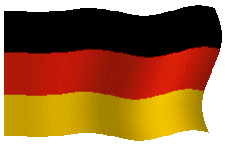

 PARIS10 #6 K�nigsplatz
PARIS10 #6 K�nigsplatz



Saturday, August 21, 2010
A little history of this important city is useful in understanding some
of the sights. From the first Duke of Bavaria,
Garibald I of the
Agilolfings line in 555 AD to the last King of Bavaria, Ludwig III
in 1918, it is unnecessary to go through every one of the over 100 that
have ruled this city over that 1,363 years. But the pivotal and
historically important ones make seeing this city more fulfilling.
It might be best to start with the founding of Munich. To read
about all of them click
here.
The year 1158 is accepted as the foundation date of the city because it
is the earliest date it is mentioned in a document which was signed in
Augsburg.
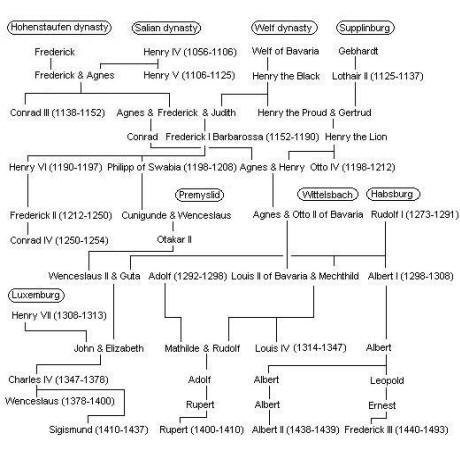
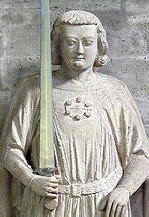 Before that
Before that
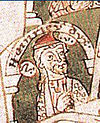 the
Guelph,
Henry the Lion (1129�95) (left) (Duke of Saxony and Bavaria) had
built a bridge over the Isar River next to a settlement of Benedictine
monks. This was on the Salt Route and was a toll bridge.
the
Guelph,
Henry the Lion (1129�95) (left) (Duke of Saxony and Bavaria) had
built a bridge over the Isar River next to a settlement of Benedictine
monks. This was on the Salt Route and was a toll bridge.
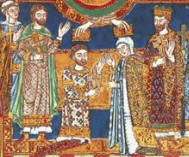 Henry's
(left, marriage to Mathilde) ancestors were the House of Welf (in
English, Guelf or Guelph.) Family chart to the right. In
1070, Welf IV became Duke of Bavaria. His son
Welf V (1072-1120) (below left) married Countess
Matilda of Tuscany who died childless and
Henry's
(left, marriage to Mathilde) ancestors were the House of Welf (in
English, Guelf or Guelph.) Family chart to the right. In
1070, Welf IV became Duke of Bavaria. His son
Welf V (1072-1120) (below left) married Countess
Matilda of Tuscany who died childless and
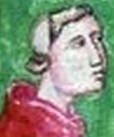 left
him all her possessions in Italy including
Tuscany,
Ferrara,
Modena,
Mantua,
and
Reggio. This played a big role in the
Investiture Controversy. Because the Welf dynasty
left
him all her possessions in Italy including
Tuscany,
Ferrara,
Modena,
Mantua,
and
Reggio. This played a big role in the
Investiture Controversy. Because the Welf dynasty
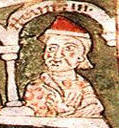 sided
with the Pope in this controversy, partisans of the Pope came to be
known in Italy as "Guelphs." It is interesting to read the
Controversy and how it led to the first formation of the College of
Cardinals for election of the pope in 1059 and its final settlement in
the Concordant of Worms in 1122. Henry IX (1075-1126) (right),
called the Black, ruled from 1120 to 1126.
sided
with the Pope in this controversy, partisans of the Pope came to be
known in Italy as "Guelphs." It is interesting to read the
Controversy and how it led to the first formation of the College of
Cardinals for election of the pope in 1059 and its final settlement in
the Concordant of Worms in 1122. Henry IX (1075-1126) (right),
called the Black, ruled from 1120 to 1126.
What is interesting, as an aside, is that in 1714
Georg Ludwig (a Welf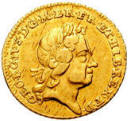
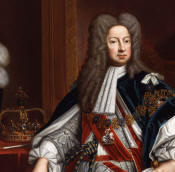 descendent and Duke of Hannover) inherited the British throne as
King George I (left, guinea right) as a result of the
Act of Settlement. His grandson
George III (right) caused
descendent and Duke of Hannover) inherited the British throne as
King George I (left, guinea right) as a result of the
Act of Settlement. His grandson
George III (right) caused
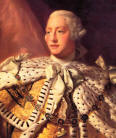 the
union of Britain and Ireland into the United Kingdom, lost the
colonies in the American Revolution, finally defeated Napoleon and
died mentally ill from porphyria. The Welf dynasty continued
to rule Great Britain (where they were known as the
House of
the
union of Britain and Ireland into the United Kingdom, lost the
colonies in the American Revolution, finally defeated Napoleon and
died mentally ill from porphyria. The Welf dynasty continued
to rule Great Britain (where they were known as the
House of
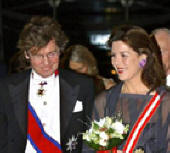 Hanover)
until the death of his granddaughter
Queen Victoria in 1901. In 1913, a descendent,
Ernst August, married the daughter of
Kaiser Wilhelm II and was allowed to inherit the duchy of
Hanover. His rule there was short-lived, however, as the
monarchy came to an end following WWI in 1918. The Welf
dynasty continues to exist today and its current head,
Ernst August V, is the third and present husband (left) of
Princess Caroline of Monaco (they are now separated.)
Hanover)
until the death of his granddaughter
Queen Victoria in 1901. In 1913, a descendent,
Ernst August, married the daughter of
Kaiser Wilhelm II and was allowed to inherit the duchy of
Hanover. His rule there was short-lived, however, as the
monarchy came to an end following WWI in 1918. The Welf
dynasty continues to exist today and its current head,
Ernst August V, is the third and present husband (left) of
Princess Caroline of Monaco (they are now separated.)
Going back; in 1175, Munich was officially granted city status and was
fortified. Henry the Lion's possessions in Bavaria and Saxony are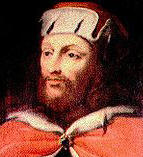 shown in the map. He was succeeded by
Otto I Wittelsbach (right) (1117-83) called the Redhead (der Rotkopf)
who
shown in the map. He was succeeded by
Otto I Wittelsbach (right) (1117-83) called the Redhead (der Rotkopf)
who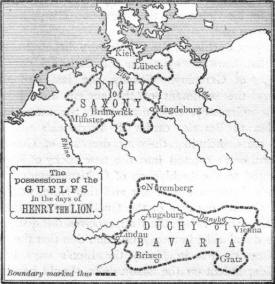 ruled from 1180-3. Otto was the first Bavarian ruler from the
House of Wittelsbach and became so after the trial of Henry the Lion who
was then deposed by his cousin, Emperor Barbarossa. His
descendants (the
Wittelsbach dynasty
ruled from 1180-3. Otto was the first Bavarian ruler from the
House of Wittelsbach and became so after the trial of Henry the Lion who
was then deposed by his cousin, Emperor Barbarossa. His
descendants (the
Wittelsbach dynasty )
ruled Bavaria for the next 738 years until 1918. It is very
interesting to click the above link and see the whole lineage. In
1240, Munich was transferred to his son
Otto II Wittelsbach (1206�53) (right) and in 1255, when the Duchy of
Bavaria was split in two, Munich became the ducal residence of
Upper Bavaria (the southern part.)
)
ruled Bavaria for the next 738 years until 1918. It is very
interesting to click the above link and see the whole lineage. In
1240, Munich was transferred to his son
Otto II Wittelsbach (1206�53) (right) and in 1255, when the Duchy of
Bavaria was split in two, Munich became the ducal residence of
Upper Bavaria (the southern part.)
Bavaria was split into two parts
twice; the first time from 1253�1340 (87 years) and the
second time from 1349�1503 (154 years.)
Louis IV became the Duke of Upper Bavaria in 1294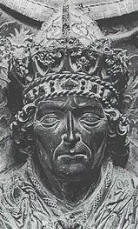 ,
was elected German king in 1314, King of Italy in 1327 and crowned as
Holy Roman Emperor in 1328. This Wittelsbach was a real big
shot. He strengthened Munich's position by granting it the salt
monopoly, thus assuring it of additional income. In January 1328,
Louis marched into Italy, entered Rome and had himself crowned emperor
by the aged senator
Sciarra Colonna. Three months later
,
was elected German king in 1314, King of Italy in 1327 and crowned as
Holy Roman Emperor in 1328. This Wittelsbach was a real big
shot. He strengthened Munich's position by granting it the salt
monopoly, thus assuring it of additional income. In January 1328,
Louis marched into Italy, entered Rome and had himself crowned emperor
by the aged senator
Sciarra Colonna. Three months later
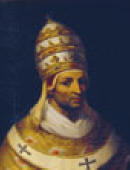 Louis
published a decree declaring "Jacque de Cahors" (Pope
John XXII) (left) deposed on grounds of heresy. There was some
basis for this, by the way. The popes were in Avignon at that time
living quite well under French protection (See France Diarios.)
Louis
published a decree declaring "Jacque de Cahors" (Pope
John XXII) (left) deposed on grounds of heresy. There was some
basis for this, by the way. The popes were in Avignon at that time
living quite well under French protection (See France Diarios.)
Louis then installed a spiritual Franciscan,
Pietro Rainalducci as
Antipope Nicholas V, but both had to flee Rome in August 1328, after
Robert, King of Naples (right) had sent both a fleet and an army
against them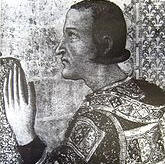 .
Pietro was the 32nd of 39 Antipopes in the history of the Church.
In fulfillment of an oath he made, on his return from Italy, Louis
founded
Ettal Abbey on April 28, 1330. We will be there next
week.
.
Pietro was the 32nd of 39 Antipopes in the history of the Church.
In fulfillment of an oath he made, on his return from Italy, Louis
founded
Ettal Abbey on April 28, 1330. We will be there next
week.
Louis inherited Lower Bavaria after the death of Duke John I in 1340,
and then reunited the Duchy of Bavaria. He died in 1347 and is
buried in the Frauenkirche. In the late 15th Century Munich
underwent a revival of gothic arts. The Old Town Hall was
enlarged, and Munich's largest gothic church, now a cathedral (Frauenkirche)
was constructed in only twenty years, starting in 1468.
When Bavaria was reunited for the second time in 1503, Munich became its
capital. Arts and politics became increasingly influenced by the
court. During the 16th Century, Munich was a center of the German
counter-reformation, and also of Renaissance arts.
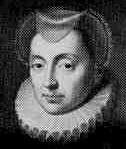 Duke
Duke
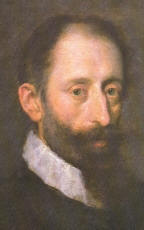 Wilhelm
V the Pious (1548�1626) (left, wife Renata right) commissioned the
Jesuit
Michaelskirche, which became a center for the counter-reformation,
and he also built the
Hofbr�uhaus (see below) for brewing brown beer in 1589. The
Catholic League was founded in Munich in 1609. In 1623 (during
the
Thirty Years' War) Munich became Electoral residence
Wilhelm
V the Pious (1548�1626) (left, wife Renata right) commissioned the
Jesuit
Michaelskirche, which became a center for the counter-reformation,
and he also built the
Hofbr�uhaus (see below) for brewing brown beer in 1589. The
Catholic League was founded in Munich in 1609. In 1623 (during
the
Thirty Years' War) Munich became Electoral residence
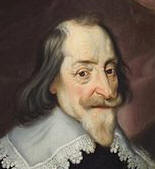 when
Maximilian I (right), Duke of Bavaria was invested with the
electoral dignity. But in 1632,
Gustav II Adolphus of
when
Maximilian I (right), Duke of Bavaria was invested with the
electoral dignity. But in 1632,
Gustav II Adolphus of
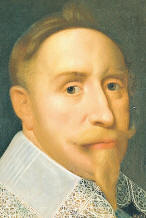 Sweden
(below left) invaded Bavaria during the Thirty Years� War and occupied
the city. He threatened to sack and burn the entire city of
Munich but would leave the city in peace if the citizens surrendered
some hostages and 600,000 barrels of Hofbr�uhaus beer. This
literally saved the city.
Sweden
(below left) invaded Bavaria during the Thirty Years� War and occupied
the city. He threatened to sack and burn the entire city of
Munich but would leave the city in peace if the citizens surrendered
some hostages and 600,000 barrels of Hofbr�uhaus beer. This
literally saved the city. Gustav was killed in a later battle and his daughter
Christina (right) became "King" of Sweden as he had dictated.
Click on her name; her life was extremely interesting and worth reading
about. After converting to Catholicism and abdicating her throne,
she spent her latter years in France and Rome, where she was buried in
St. Peter's Basilica. But I digress.
Gustav was killed in a later battle and his daughter
Christina (right) became "King" of Sweden as he had dictated.
Click on her name; her life was extremely interesting and worth reading
about. After converting to Catholicism and abdicating her throne,
she spent her latter years in France and Rome, where she was buried in
St. Peter's Basilica. But I digress.
When the bubonic plague broke out in Munich in 1634-5 about
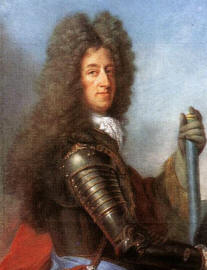 one
third of the population died. Under the regency of the Bavarian
Electors, Munich was an important center of baroque life but also had to
suffer under
Habsburg occupations in 1704 and 1742.
Maximilian II Emanuel (1679-1726) (left) grandson of Max I, took
part in the
War of the Spanish Succession on the side of France, against the
Holy Roman Emperor
Leopold I. He was then forced to flee Bavaria following the
Battle of Blenheim
one
third of the population died. Under the regency of the Bavarian
Electors, Munich was an important center of baroque life but also had to
suffer under
Habsburg occupations in 1704 and 1742.
Maximilian II Emanuel (1679-1726) (left) grandson of Max I, took
part in the
War of the Spanish Succession on the side of France, against the
Holy Roman Emperor
Leopold I. He was then forced to flee Bavaria following the
Battle of Blenheim
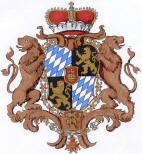 in
1706 but regained it in 1714 by the
Peace of Baden and he ruled until 1726.
Maximilian III Joseph (below left, arms right)
in
1706 but regained it in 1714 by the
Peace of Baden and he ruled until 1726.
Maximilian III Joseph (below left, arms right)
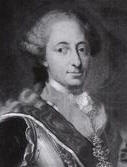 (1745-77)
was childless and became the last of the direct Wittelsbach line from
Louis IV. He was succeeded by
Charles (Karl) Theodore (right) (1977-99,) who thereby
(1745-77)
was childless and became the last of the direct Wittelsbach line from
Louis IV. He was succeeded by
Charles (Karl) Theodore (right) (1977-99,) who thereby
.jpg/80px-Kurf�rst_Karl_Theodor_(Bayern).jpg) regained
their old titles for the senior Wittelsbach line, descending from Louis
IV's older brother
Rudolf I. Karl was not popular and was also childless.
He was succeeded by a distant cousin, the
Count Palatine of Zweibr�cken,
Maximilian IV Joseph (see below.)
regained
their old titles for the senior Wittelsbach line, descending from Louis
IV's older brother
Rudolf I. Karl was not popular and was also childless.
He was succeeded by a distant cousin, the
Count Palatine of Zweibr�cken,
Maximilian IV Joseph (see below.)
In 1806, the city became the capital of the new
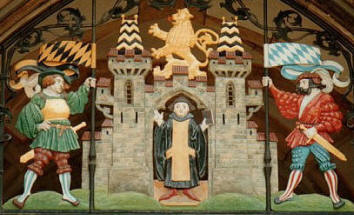 Kingdom
of Bavaria, with the state's parliament (Landtag)
and the new
archdiocese of Munich and Freising being located in the city.
The city's coat of arms is left. Twenty years later
Landshut University was moved to Munich. The first three
Bavarian kings saw
Kingdom
of Bavaria, with the state's parliament (Landtag)
and the new
archdiocese of Munich and Freising being located in the city.
The city's coat of arms is left. Twenty years later
Landshut University was moved to Munich. The first three
Bavarian kings saw
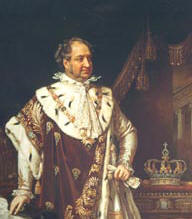 the
erection of many of the city's finest buildings. With Napoleon
causing the collapse of the Holy Roman Empire, the Prince (Emperor)
Elector of Bavaria,
the
erection of many of the city's finest buildings. With Napoleon
causing the collapse of the Holy Roman Empire, the Prince (Emperor)
Elector of Bavaria,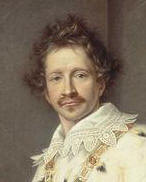
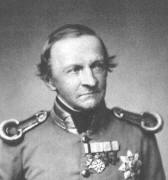 Maximilian IV Joseph (right,) then took title as the first King of
Bavaria with the name
Maximilian I and ruled from 1805-25. He was succeeded by his
son
Ludwig I (left) who ruled from 1825-48 and then by his son,
Maximilian II from 1848-64. Max II was well liked by the
people and pictured is one of the memorial statues erected of him (below
left.) He is pictured in royal garb (center left) and in a photo
of him hunting (center right.) Below right is a photo of him with
his wife
Marie and their two sons, Ludwig II (left) and Otto (right.)
Maximilian IV Joseph (right,) then took title as the first King of
Bavaria with the name
Maximilian I and ruled from 1805-25. He was succeeded by his
son
Ludwig I (left) who ruled from 1825-48 and then by his son,
Maximilian II from 1848-64. Max II was well liked by the
people and pictured is one of the memorial statues erected of him (below
left.) He is pictured in royal garb (center left) and in a photo
of him hunting (center right.) Below right is a photo of him with
his wife
Marie and their two sons, Ludwig II (left) and Otto (right.)
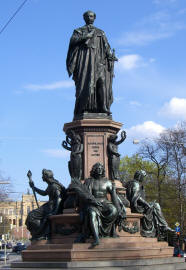
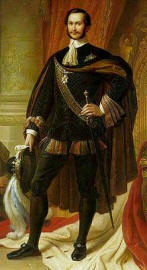
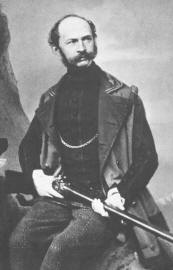
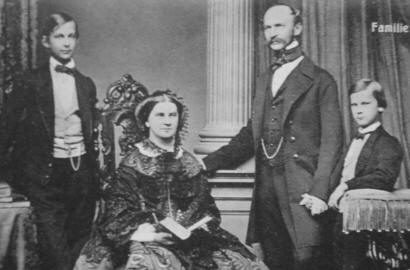
Now we get to the succession of his oldest son, the famous
Ludwig II
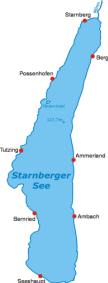 (below
left) who rules from 1864 until his untimely suspicious
(below
left) who rules from 1864 until his untimely suspicious
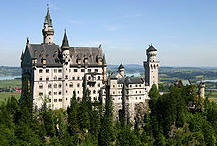 death
by drowning in Lake Starnberger See (left) near the small town of Berg
in 1886. He built the famous castles (including the "fairytale"
Schloss Neuschwanstein castle (right)) and practically bankrupted the
kingdom in the process. He built one on the small and only island
on the lake called Roseninsel. He was succeeded by his brother
Otto (below right) from 1886-1913. But after ruling for 27 years,
poor Otto developed mental illness and he had to be confined. He
was replaced by his older relative, Ludwig III from 1913-18 (see below.)
death
by drowning in Lake Starnberger See (left) near the small town of Berg
in 1886. He built the famous castles (including the "fairytale"
Schloss Neuschwanstein castle (right)) and practically bankrupted the
kingdom in the process. He built one on the small and only island
on the lake called Roseninsel. He was succeeded by his brother
Otto (below right) from 1886-1913. But after ruling for 27 years,
poor Otto developed mental illness and he had to be confined. He
was replaced by his older relative, Ludwig III from 1913-18 (see below.)
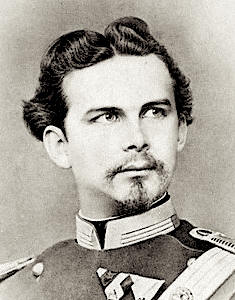
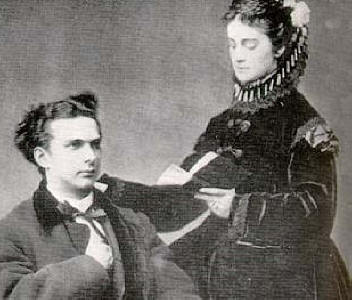
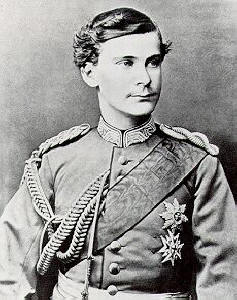
Following the outbreak of WWI in 1914, life in Munich became very
difficult, as the Allied blockade
 of
Germany led to food and fuel shortages. During
of
Germany led to food and fuel shortages. During
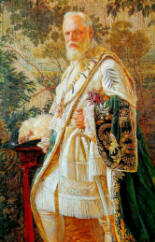 French
air raids in 1916, three bombs fell on Munich. After the war, the
city was the center of much political unrest. In November 1918, on
the eve of a revolution,
Ludwig III (left & right) and his family fled the city. That
was the end of the Wittelsbachs. After the murder of the first
republican Premier of
Bavaria, Jewish Socialist
Kurt Eisner, (below left) in February 1919 by
Anton Graf von Arco, (below right) a Jewish anti-Semite.
Hitler attended Eisner's funeral
French
air raids in 1916, three bombs fell on Munich. After the war, the
city was the center of much political unrest. In November 1918, on
the eve of a revolution,
Ludwig III (left & right) and his family fled the city. That
was the end of the Wittelsbachs. After the murder of the first
republican Premier of
Bavaria, Jewish Socialist
Kurt Eisner, (below left) in February 1919 by
Anton Graf von Arco, (below right) a Jewish anti-Semite.
Hitler attended Eisner's funeral
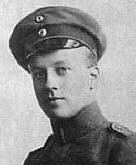
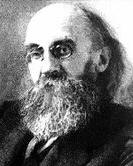 wearing
both black and red arm bands. Anton received the death
penalty which a conservative judge reduced to 5 years. He was
released from prison to make room for Hitler to take his cell (ironic,
see below.)
wearing
both black and red arm bands. Anton received the death
penalty which a conservative judge reduced to 5 years. He was
released from prison to make room for Hitler to take his cell (ironic,
see below.)
Immediately afterward, the
Bavarian Soviet Republic was proclaimed. When Communists had
taken power,
Lenin (who had lived in Munich years earlier,) sent a congratulatory
telegram, but the Soviet Republic was put down on May 3, 1919 by the
conservative
Freikorps. While the republican government had been restored,
Munich subsequently became a hotbed of extremist politics, among which
Adolf Hitler and National Socialism rose to prominence. In 1923,
Hitler had his Beer Hall Putsch temporarily crippling the Nazi Party
(see Diario #5.) The city again become a Nazi stronghold when the
National Socialists took power in Germany in 1933.
They created the first concentration camp at
Dachau (10 miles (16 km) NW of the city.) Because of its
importance to the rise of National Socialism, Munich was referred to as
the Hauptstadt der Bewegung ("Capital of the Movement.") The Nazi
headquarters were in Munich and many F�hrerbauten ("F�hrer-buildings")
were built around the
K�nigsplatz, some of which have survived to this day (see below.)
Munich was also the base of the
White Rose, a group of students that formed a resistance movement
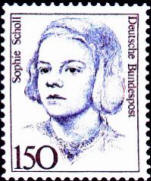
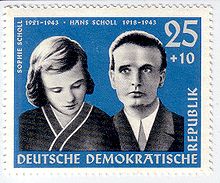 against
Hitler and the Nazi government from June 1942 to February 1943.
The six core members of the group were arrested by the Gestapo and they
were executed by decapitation in 1943. This happened following a
distribution of leaflets at
Munich University by siblings Hans and Sophie Scholl
and Christoph Probst.
Left is an East Germany stamp of the Scholls from 1961 and right showing
Sophie from West Germany in 1991. In the photo below from 1943
are, from
left Hans Scholl,
his sister Sophie
Scholl, and
Christoph Probst.
against
Hitler and the Nazi government from June 1942 to February 1943.
The six core members of the group were arrested by the Gestapo and they
were executed by decapitation in 1943. This happened following a
distribution of leaflets at
Munich University by siblings Hans and Sophie Scholl
and Christoph Probst.
Left is an East Germany stamp of the Scholls from 1961 and right showing
Sophie from West Germany in 1991. In the photo below from 1943
are, from
left Hans Scholl,
his sister Sophie
Scholl, and
Christoph Probst.
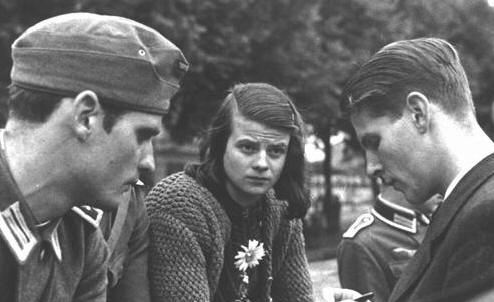
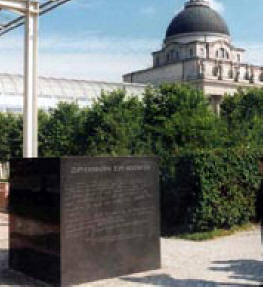
They are considered heroes and are buried (below left) in the Perlacher
Friedhof next to the Stadelheim prison in Munich (where both Anton and
Hitler had been held.) Above right is a memorial to them near the
Hofgarten. Below right is the memorial to them in Ludwig
University depicting the leaflets distributed.
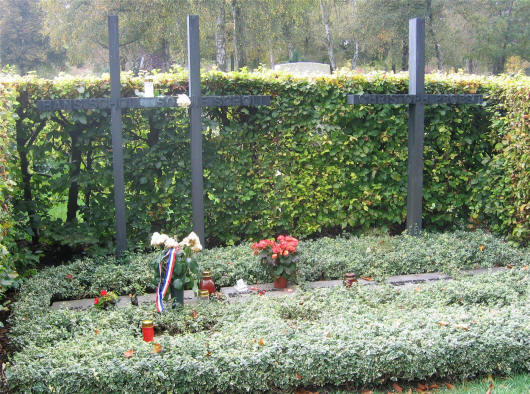
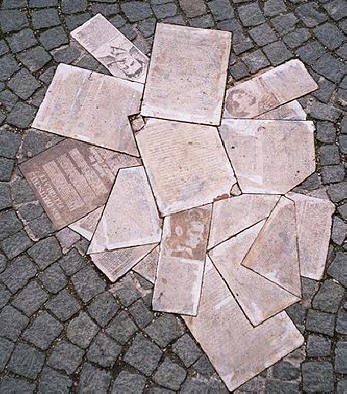
The history of Munich would be deplete without mentioning the
history of the famous
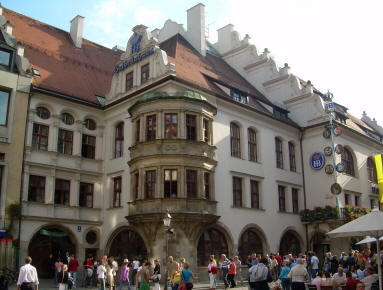
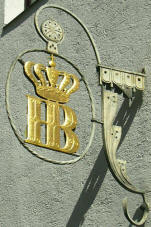 Hofbr�uhaus
am Platzl [Platzl 9, +49-89-29-013-6100,
hbteam@hofbraeuhaus.de.]
It was founded in 1589 by Wilhelm V. It is one of Munich�s
oldest beer halls. It was originally founded as the
brewery to the old Royal Residence, which at that time was
situated just around the corner from where the beer hall stands
today.
Hofbr�uhaus
am Platzl [Platzl 9, +49-89-29-013-6100,
hbteam@hofbraeuhaus.de.]
It was founded in 1589 by Wilhelm V. It is one of Munich�s
oldest beer halls. It was originally founded as the
brewery to the old Royal Residence, which at that time was
situated just around the corner from where the beer hall stands
today. It was moved to this location in 1607 by his son Maximillian I.
The beer quickly became world famous thanks to the first brewer,
Heimeran Pongratz, and the famous �Bavarian Beer Purity Law� of
1516 that stated that only natural ingredients could be used in
the brewing process. King Ludwig I in 1828, issued a
decree that opened up the
It was moved to this location in 1607 by his son Maximillian I.
The beer quickly became world famous thanks to the first brewer,
Heimeran Pongratz, and the famous �Bavarian Beer Purity Law� of
1516 that stated that only natural ingredients could be used in
the brewing process. King Ludwig I in 1828, issued a
decree that opened up the
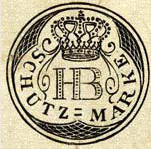 Hofbr�uhaus
to the public, marking the
Hofbr�uhaus
to the public, marking the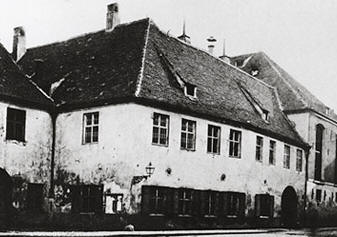 onset of the operation of the Hofbr�uhaus at Platzl as we know
it today. In 1852 Maximillian II transferred it to the
Bavarian State. In 1879, they patented this logo (left) to
prevent others from using it.
onset of the operation of the Hofbr�uhaus at Platzl as we know
it today. In 1852 Maximillian II transferred it to the
Bavarian State. In 1879, they patented this logo (left) to
prevent others from using it.
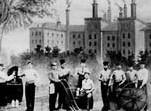 Prince
Regent Luitpold decided to move the brewery out of the
Hofbr�uhaus and to build a completely new brewing site (left)
above the storage cellars on Innere Wiener Street. The
last batch of beer was brewed at the old site on May 22, 1896.
The new Hofbr�uhaus
Prince
Regent Luitpold decided to move the brewery out of the
Hofbr�uhaus and to build a completely new brewing site (left)
above the storage cellars on Innere Wiener Street. The
last batch of beer was brewed at the old site on May 22, 1896.
The new Hofbr�uhaus
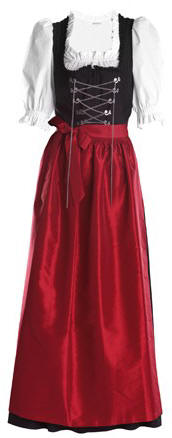 opened
on September 22, 1897. On the night of April 25, 1944, the
first airborne bombs struck the Hofbr�uhaus. Three subsequ
opened
on September 22, 1897. On the night of April 25, 1944, the
first airborne bombs struck the Hofbr�uhaus. Three subsequ ent
air raids almost completely destroyed the building and only a
small section of the main beer hall was still operational � all
other rooms had been destroyed. Just in time for Munich �s
800th anniversary, the Hofbr�uhaus� new Festival Hall reopened,
marking the end of the renovation work. Today it is run by
the landlords, Wolfgang and Michael Sperger. To buy HB
products click
SHOP. You can even buy a classic dirndl (right) for
about �200.
ent
air raids almost completely destroyed the building and only a
small section of the main beer hall was still operational � all
other rooms had been destroyed. Just in time for Munich �s
800th anniversary, the Hofbr�uhaus� new Festival Hall reopened,
marking the end of the renovation work. Today it is run by
the landlords, Wolfgang and Michael Sperger. To buy HB
products click
SHOP. You can even buy a classic dirndl (right) for
about �200.
Wolfgang Amadeus Mozart lived around
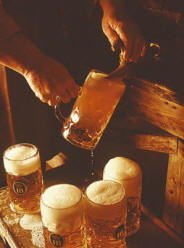 the
block from the famous beer hall
the
block from the famous beer hall
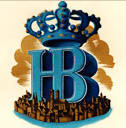 in
the late 18th Century. In a poem he wrote, Mozart claimed
to have written the opera "Idomeneo" after several visits to the
Hofbr�uhaus fortified him for the task. In the 19th
Century, most of the breweries in Munich, including the
Hofbr�uhaus, were converted into large beer halls, restaurants,
and entertainment centers with large, cavernous meeting rooms
for weddings, concerts, and plays. In the period after
WWI, the beer halls of Munich became swept up in the chaotic
politics of the period. Vladimir Lenin lived in Munich
just before WWI and reportedly visited the Hofbr�uhaus on a
regular basis. In 1919, the Munich Communist government
set up
in
the late 18th Century. In a poem he wrote, Mozart claimed
to have written the opera "Idomeneo" after several visits to the
Hofbr�uhaus fortified him for the task. In the 19th
Century, most of the breweries in Munich, including the
Hofbr�uhaus, were converted into large beer halls, restaurants,
and entertainment centers with large, cavernous meeting rooms
for weddings, concerts, and plays. In the period after
WWI, the beer halls of Munich became swept up in the chaotic
politics of the period. Vladimir Lenin lived in Munich
just before WWI and reportedly visited the Hofbr�uhaus on a
regular basis. In 1919, the Munich Communist government
set up
 headquarters
in the famous beer hall, and in 1920 Adolf Hitler and the
National Socialists held their first meeting in the Festsaal
(Festival Room) on the third floor. It was used by the
Nazi Party to declare policies and hold functions. On
February 24, 1920,
Adolf Hitler proclaimed the 25 theses of the
National Socialist program at the Hofbr�uhaus, which
reconstituted the German Workers' Party as the National
Socialist German Workers' Party, known as the Nazi Party.
Hitler�s experiences with the Hofbr�uhaus were limited to
political events and later commemorations. The famous
�Beer Hall Putsch� of 1923 actually took place in another beer
hall called Burgerbr�ukeller (below left,) which used to stand
on the east side of the city where a Hilton Hotel now stands.
headquarters
in the famous beer hall, and in 1920 Adolf Hitler and the
National Socialists held their first meeting in the Festsaal
(Festival Room) on the third floor. It was used by the
Nazi Party to declare policies and hold functions. On
February 24, 1920,
Adolf Hitler proclaimed the 25 theses of the
National Socialist program at the Hofbr�uhaus, which
reconstituted the German Workers' Party as the National
Socialist German Workers' Party, known as the Nazi Party.
Hitler�s experiences with the Hofbr�uhaus were limited to
political events and later commemorations. The famous
�Beer Hall Putsch� of 1923 actually took place in another beer
hall called Burgerbr�ukeller (below left,) which used to stand
on the east side of the city where a Hilton Hotel now stands.


In 1939, an anti-Nazi (communist) workman,
Georg Elser
(left), concealed a time bomb in the B�rgerbr�ukeller,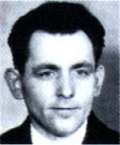 set to go off during Hitler's speech on November 8th. The bomb
exploded, killing 7 people and injuring 63, but Hitler left a
half hour earlier than planned and escaped unharmed. If
only, huh? Above right is a photo of it after the bombing.
Elser was imprisoned at Dachau until they executed him at the
end of the war.
set to go off during Hitler's speech on November 8th. The bomb
exploded, killing 7 people and injuring 63, but Hitler left a
half hour earlier than planned and escaped unharmed. If
only, huh? Above right is a photo of it after the bombing.
Elser was imprisoned at Dachau until they executed him at the
end of the war.
Since Hitler
did not drink alcohol, eat red meat, or smoke, the beer hall was
not his scene. His favorite restaurant in Munich was an
Italian restaurant near Munich�s famed Ludwig-Maximillian
University. Before he turned to politics, one of Hitler's
watercolors was of the Hofbr�uhaus.
After WWII, the Hofbr�uhaus quickly became Munich�s number one
tourist
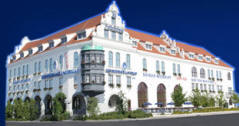 attraction.
Hofbr�uhauses have opened in Hamburg (2005,) Bremen (2008,)
Regensburg, Kaiserslautern and Berchtesgaden.
Hofbr�uhauses have been operating in Melbourne, Australia since
1968 as
attraction.
Hofbr�uhauses have opened in Hamburg (2005,) Bremen (2008,)
Regensburg, Kaiserslautern and Berchtesgaden.
Hofbr�uhauses have been operating in Melbourne, Australia since
1968 as
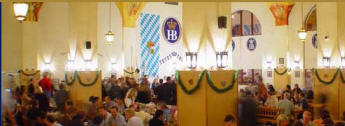 well
as Newport, Kentucky (2003,) Las Vegas, Miami Beach, Chicago,
Milwaukee, and Pittsburgh (2009.) They are also in
Genoa,
Italy, Stockholm, Dubai, and the first in Asia in Seoul, Korea
and Bangkok. The
Hofbr�uhaus Las
Vegas [4510 Paradise Rd, 702-853-BEER] (above & right) is
the first full-scale replica of the Munich beer hall anywhere in
the world.
well
as Newport, Kentucky (2003,) Las Vegas, Miami Beach, Chicago,
Milwaukee, and Pittsburgh (2009.) They are also in
Genoa,
Italy, Stockholm, Dubai, and the first in Asia in Seoul, Korea
and Bangkok. The
Hofbr�uhaus Las
Vegas [4510 Paradise Rd, 702-853-BEER] (above & right) is
the first full-scale replica of the Munich beer hall anywhere in
the world.
On this our 4th day, I woke at 12:20, 2:00, 5:30,
and from a dream at 7:45. At 9:10 I got up, dressed for running while
Marcia was downstairs having her breakfast almost alone because it was last
call.
.JPG)
By 9:35
I was at the Rosen Apoteke and at 9:50 I was walking again to Odeonsplatz (below
left.)
.JPG)
.JPG)
At 10:00 I had my cappuc.jpg) cino at SFCC
(above left)
cino at SFCC
(above left)
.jpg) doing my usual daily computer
chores. At 11:00 I walked across the street (above right,) through the
gate and did my run in the Hofgarten (below) and calculated, using my pedometer,
that it takes 4 circuits around the the outer lane of the park to make a mile
(1.61 km.)
doing my usual daily computer
chores. At 11:00 I walked across the street (above right,) through the
gate and did my run in the Hofgarten (below) and calculated, using my pedometer,
that it takes 4 circuits around the the outer lane of the park to make a mile
(1.61 km.)
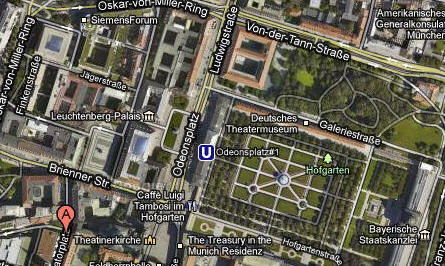
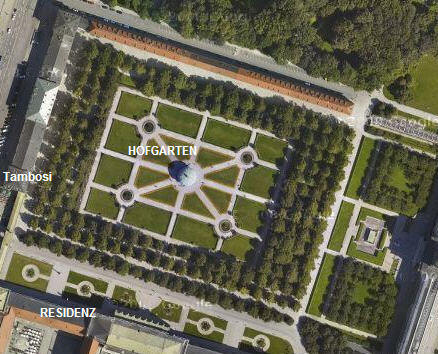
This became
my favorite place to run because I didn't have to watch out for the trams and
bicyclists and there weren't too many tourists to navigate through. Below
are the views looking forward (right) and backward (left) half way down one leg.
.JPG)
.JPG)
Below is a
view of the center of the park, half way down the inner path, with the little
cupola in the center.
.jpg)
As you pass
the back end of the park, you see a view of the Staatskanzlei (Bavarian State
Chancelery.) The White Rose memorial is here and the underground soldier's
memorial can be seen behind the building.

Below is the
lane in front of the building all covered with trees at one end of Hofgarten
(left) and the seating outside of Tambosi's at the other end (right.)
.JPG)
.JPG)
On the left
is an aerial shot from Bing maps showing the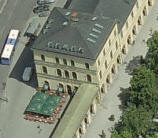 outdoor seating on both sides of the wall. I took this photo (below) of
the sign showing the extent of the famous Englischer Garten, which is the
largest park within the city limits of any city. I did not go there
because we have covered it on several previous trips. It is definitely
worthwhile visiting, especially the 4 major biergartens they have there.
outdoor seating on both sides of the wall. I took this photo (below) of
the sign showing the extent of the famous Englischer Garten, which is the
largest park within the city limits of any city. I did not go there
because we have covered it on several previous trips. It is definitely
worthwhile visiting, especially the 4 major biergartens they have there.
.jpg)
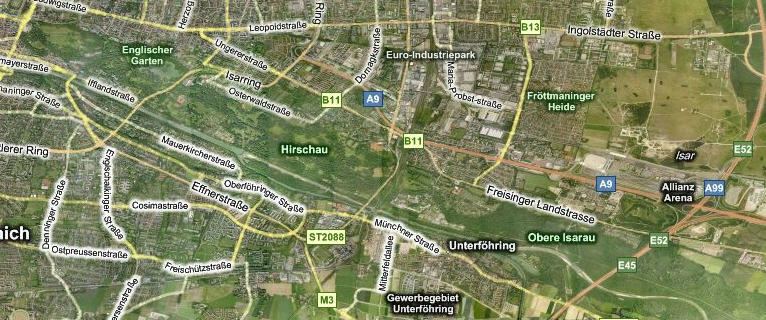
Above is a
Bing map of the English Garden showing its full extent. I finished my run
through the streets and passed by this side of the Residenz (below.)
.jpg)
These are my
two attempts using Photostitch to show the entire extent of it.
.jpg)
.jpg)
I walked down
Briennerstra�e and came across Maximilianplatz (Wittelsbacherplatz) in honor of
the Wittelsbachs, of course.
.JPG)
Below is a
Bing aerial of the square.
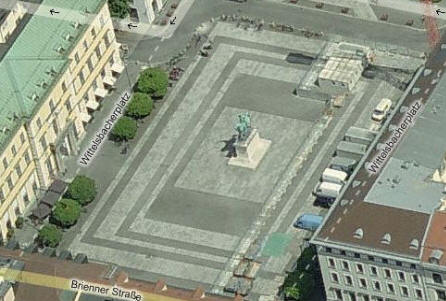
.JPG)
.JPG)
At the center of the square is the equestrian statue of Maximilian I (above and
below) erected by King Ludwig I in October 1839. Fuerst means Prince but
don't know what the "Chur" in front of it means. Maybe "elector"?
.jpg)
.JPG)
.jpg)
There were several nice art galleries along
.jpg) Briennerstra�e and I got a shot of
this excellent watercolor by
Detlev Nitschke (born 1935) titled "Blumenmarkt in Rom" or "Flower Market in
Rome." It was appropriate with the nice flowers on the street. To
see more of his excellent work, click his name.
Briennerstra�e and I got a shot of
this excellent watercolor by
Detlev Nitschke (born 1935) titled "Blumenmarkt in Rom" or "Flower Market in
Rome." It was appropriate with the nice flowers on the street. To
see more of his excellent work, click his name.
.JPG)
.JPG)
Munich has
many tour buses visiting the sites as most cities do. I caught one coming
and one going.
.JPG)
.JPG)
I then went back to the SFCC and had another cappuccino but this time I sat out
in their courtyard in the back watching the fountain flowing. There are
two shots of the outdoor seating.
.JPG)
.JPG)
This edifice
was erected in 1819 and refurbished in 1950 after the war.
.jpg)
.jpg)
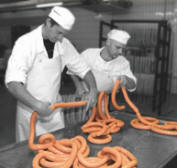 At 12:10 Marcia was out buying arch pads at Orthofit [6 F�rbergraben,
+49-892-350-8270] nearby the hotel and then went to the same Rosen Apoteke
before having lunch at Vinzenzmurr [8 Marienplatz, +49-8-922-1938.] They
are famous for their sausages.
At 12:10 Marcia was out buying arch pads at Orthofit [6 F�rbergraben,
+49-892-350-8270] nearby the hotel and then went to the same Rosen Apoteke
before having lunch at Vinzenzmurr [8 Marienplatz, +49-8-922-1938.] They
are famous for their sausages.
At 2:30 I left the SFCC and discovered that right near by there is the Odeonsplatz Ubahn
station entrance (below left.) I decided to try this as a way to find
K�nigsplatz. So I went
down into the subway which is a long escalator ride down (below right.)
.JPG)
.JPG)
I had no idea how to buy a ticket but finally found this machine (below) which
sells them in a very complicated fashion. There were too many options.
.jpg)
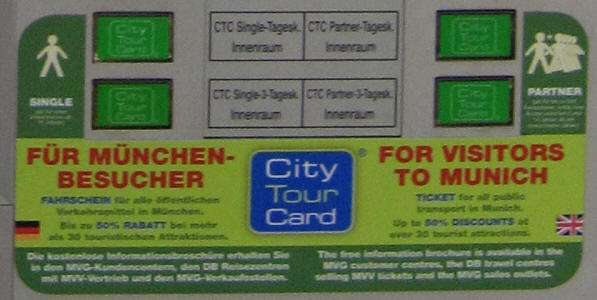
I finally gave up a bought a single ticket for �2.4 (below left.) Then I
took a look at this map (below right) showing all the train routes in Munich and
was even more confused so finally had to ask how to get to Karlsplatz.
.jpg)
.jpg)
I took the train
(below left) and arrived at the Karlsplatz station at 2:40. This place
was an immense underground shopping center (below right.)
.JPG)
.JPG)
I arrived at Karlsplatz station which is divided into five levels. Level
1, just below road
.jpg) level,
is home to a large shopping mall which is soon due for renovation. Large
shops like Kaufhof have branches here. Level 2 has a branch of the
Stadtsparkasse, a large local bank, as well as ticket counters and eateries.
Level 3 holds the S-Bahn station with two tracks and three platforms, arranged
in the Spanish solution (the island platform is for boarding only and the side
platforms are for disembarking.) The lines S1-2 and S4-8 stop here.
Level 4 allows interchange between the S-Bahn and U-Bahn. Level 5 holds
the U-Bahn station with two tracks and two platforms. Lines U4 and U5 stop
here, travelling in a N-W direction. The station is the deepest in the
whole network and thus has the longest escalator.
level,
is home to a large shopping mall which is soon due for renovation. Large
shops like Kaufhof have branches here. Level 2 has a branch of the
Stadtsparkasse, a large local bank, as well as ticket counters and eateries.
Level 3 holds the S-Bahn station with two tracks and three platforms, arranged
in the Spanish solution (the island platform is for boarding only and the side
platforms are for disembarking.) The lines S1-2 and S4-8 stop here.
Level 4 allows interchange between the S-Bahn and U-Bahn. Level 5 holds
the U-Bahn station with two tracks and two platforms. Lines U4 and U5 stop
here, travelling in a N-W direction. The station is the deepest in the
whole network and thus has the longest escalator.
I climbed the stairs out of the station, got outside and found that this was
not where I wanted to go. I realized I was trying to get to K�nigsplatz,
not Karlsplatz. You can see how easy that would be to mix up.
So I took a few photos of the Karlsplatz area. The first thing you see is,
of course, one of the three city gates I mentioned yesterday, Karlstor built in
1701. I could go through the gate and continue down Kaufingerstra�e and
reach the hotel.
.JPG)
.jpg)
Below is one of the two large curved buildings just past the gate ...
.jpg)
... and then there is the huge fountain the kids like to run
in.
.JPG)
I then went back down the stairs into the underground and transferred to Ubahn 4 heading to the Hauptbahnhof
(main train station) where I thought I would get close to K�nigsplatz.
Well I wound up being wrong again. This main station is huge (below.)
.JPG)
If
you step out the front door of the station on Bayerstra�e (below left,) you can see the Accor Sofitel Munich
(below right) where we stayed
at the start and end of our Germany Trip in 2007.
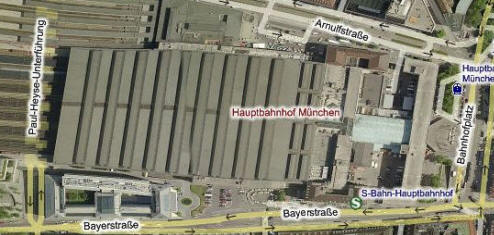
.JPG)
Of
course, that is where all the Mercedes taxis
.jpg) stand. I went inside and
stand. I went inside and
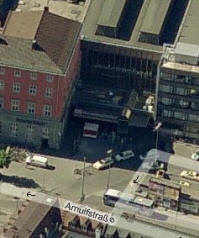 headed to the other end of the station and went outside
onto Arnulfstra�e (left.) I tried looking at maps
and asking directions. At 3:15, I just kept walking and I wound up at the corner of Luisenstra�e
and Elisenstra�e. I was completely lost.
There, I came across this
interesting building that I
headed to the other end of the station and went outside
onto Arnulfstra�e (left.) I tried looking at maps
and asking directions. At 3:15, I just kept walking and I wound up at the corner of Luisenstra�e
and Elisenstra�e. I was completely lost.
There, I came across this
interesting building that I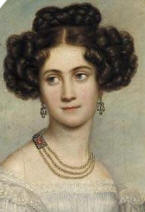
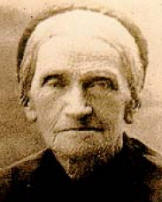 discovered is the
St�dtisches
Luisengymnasium (Municipal Luise
High School,) an 823-student, 8-year high school specializing in languages.
It was founded as the oldest high school in 1822 as a girl's school (became
co-ed in 1969) in honor of
Princess (left)
Ludovica Wilhelmine (Duchess Luise, 1808-92) who was the 6th child of
Maximilian I Joseph. Above right is a photo of Luise taken in
1890 when she was 81. She had ten children and enjoyed living
discovered is the
St�dtisches
Luisengymnasium (Municipal Luise
High School,) an 823-student, 8-year high school specializing in languages.
It was founded as the oldest high school in 1822 as a girl's school (became
co-ed in 1969) in honor of
Princess (left)
Ludovica Wilhelmine (Duchess Luise, 1808-92) who was the 6th child of
Maximilian I Joseph. Above right is a photo of Luise taken in
1890 when she was 81. She had ten children and enjoyed living
 in
the palace near Lake Stargensee. Luise was in the famous painting of the
three sisters (below left) by
Joseph Karl Stieler
(left) (1781-1858.) Luise is on the left with her sisters
Maria Anna und
Sophie Friederike. Stieler also is well known for his portraits of
Beethoven (below center) done in 1820 and of Goethe (below right) done in 1828.
in
the palace near Lake Stargensee. Luise was in the famous painting of the
three sisters (below left) by
Joseph Karl Stieler
(left) (1781-1858.) Luise is on the left with her sisters
Maria Anna und
Sophie Friederike. Stieler also is well known for his portraits of
Beethoven (below center) done in 1820 and of Goethe (below right) done in 1828.


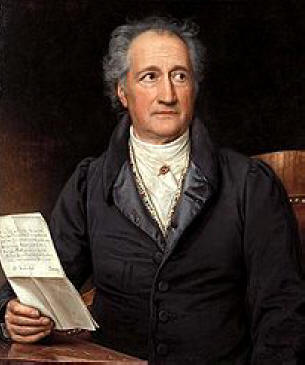
Below left is the school as I passed it and a Bing map of it on the right
showing the Charles Hotel across the street.
.JPG)
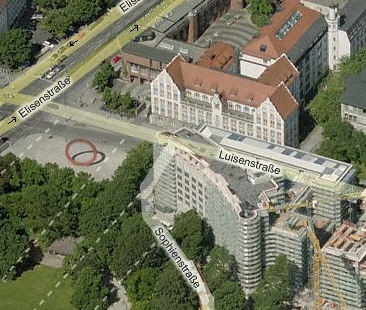
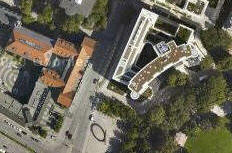 So at
3:40 I found this huge red circle sculpture (below) and came to find out I was
at the side
of the Charles Hotel, a very upscale hotel. In my running shorts, I went inside this very posh place
and begged for directions. The nice lady told me I was very close and it
was just two more blocks.
So at
3:40 I found this huge red circle sculpture (below) and came to find out I was
at the side
of the Charles Hotel, a very upscale hotel. In my running shorts, I went inside this very posh place
and begged for directions. The nice lady told me I was very close and it
was just two more blocks.
.JPG)
.JPG)
Feeling reassured, I continued on and finally came across what I found out was
my destination, the famous K�nigsplatz. Below are Bing map shots of the
grounds.

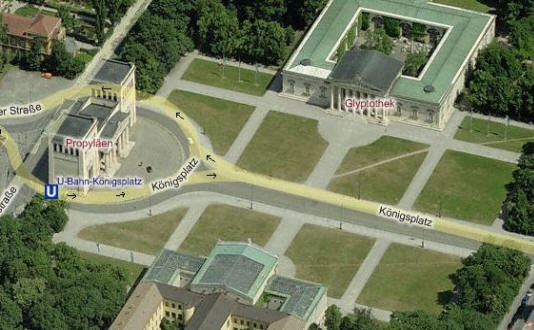
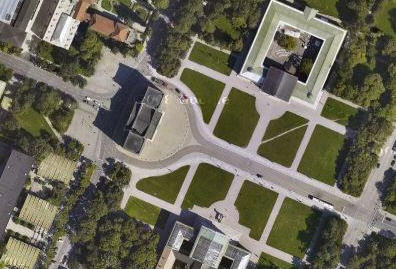
Above is the Google map to compare with the Bing. Below left is my shot of the main entry
gate called the
Propyl�en which took four photographs using PhotoStitch to make because I couldn't get
far enough back to get it all in in one shot. After walking around it, I
got a regular shot of the other side (below right.)
%20(2).jpg)
.JPG)
Here are some more Bing map shots of it. As can be seen, it is very
symmetric, looking the same from the front and the back.
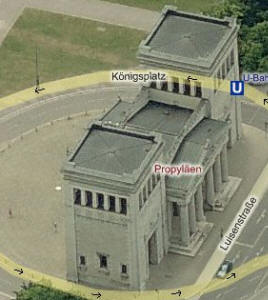
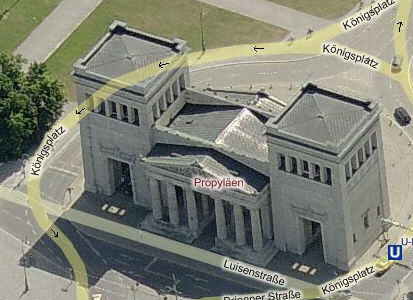
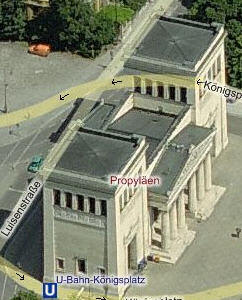
This
 K�nigsplatz area is a huge parade
K�nigsplatz area is a huge parade
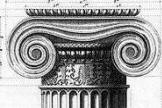 ground.
The Propyl�en has Doric columns (left,) while the
Glyptothek
(Sculpture Museum) has Ionic columns (right.) Across the way is the
Staatliche Antikensammlungen (State
Museum of Classical Art) which has Corinthian columns
ground.
The Propyl�en has Doric columns (left,) while the
Glyptothek
(Sculpture Museum) has Ionic columns (right.) Across the way is the
Staatliche Antikensammlungen (State
Museum of Classical Art) which has Corinthian columns
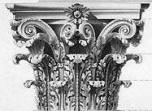 (below
left.) K�nigsplatz is completed by the
St. Boniface's Abbey (below) on its back side. The Abbey (Abtei St.
Bonifaz) is a Benedictine monastery founded in 1835 by King Ludwig I as a part
of his efforts to reanimate the country's spiritual life by the restoration of
the monasteries destroyed during the secularization of the early 19th century.
It was formally dedicated in 1850 but was destroyed in WWII and only partly
restored. The church contains the tomb of King Ludwig I. Below right is
how its interior looked in 1900.
(below
left.) K�nigsplatz is completed by the
St. Boniface's Abbey (below) on its back side. The Abbey (Abtei St.
Bonifaz) is a Benedictine monastery founded in 1835 by King Ludwig I as a part
of his efforts to reanimate the country's spiritual life by the restoration of
the monasteries destroyed during the secularization of the early 19th century.
It was formally dedicated in 1850 but was destroyed in WWII and only partly
restored. The church contains the tomb of King Ludwig I. Below right is
how its interior looked in 1900.
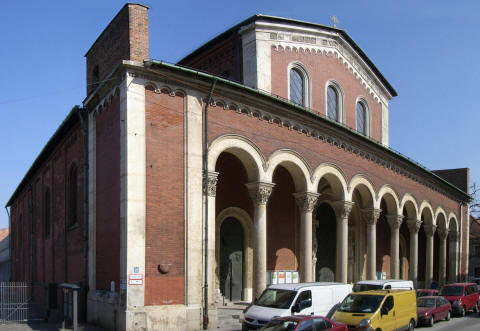
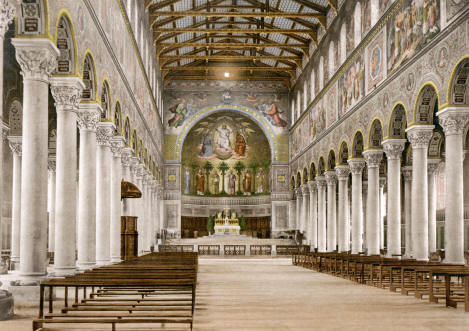
The Propyl�en was completed by
Leo
von Klenze in 1862 and is meant to evoke the monumental entrance of the
Propylaea
(below left) (#5 in map) of the
Acropolis (below right) in Athens. The K�nigsplatz Propyl�en was
created as a memorial for the accession to the throne of
Otto of Greece, King Ludwig I's son.
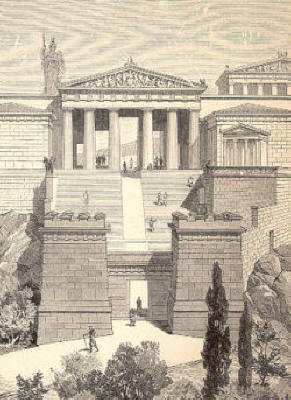
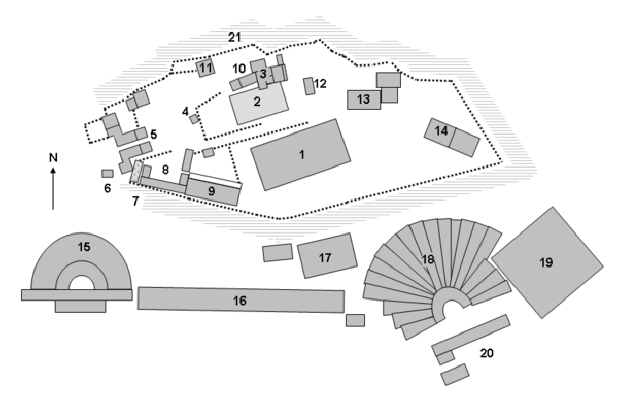
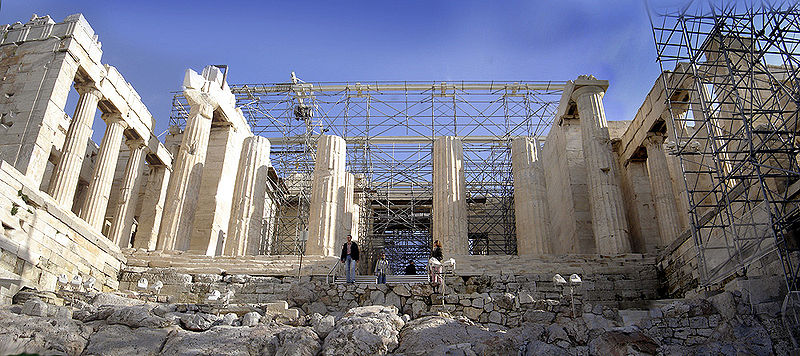
Above is how the Greek Propylaea looks today during reconstruction.
As a beautiful and monumental place, the K�nigsplatz was used by the
Third Reich as a field for the Nazi Party's mass rallies.
Below shows Nazi troops marching through the Propyl�en and Hitler and
Mussolini reviewing troops.
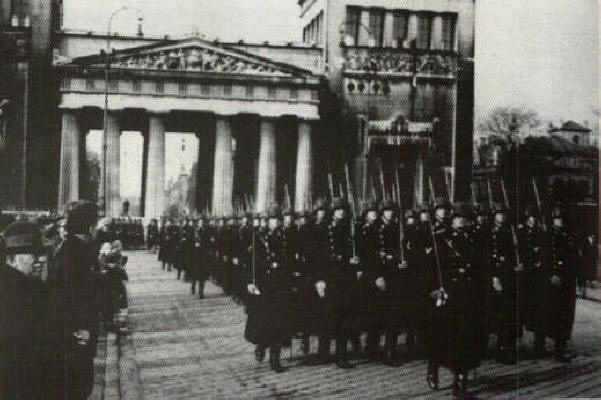

Two "Honor Temples" ( Ehrentempel)
(below) were erected at the east end of the square (left, below right)
for the remains of the 16 Nazis who died in the 1923 Beer Hall Putsch.
In 1935, the bodies of the 16 dead putschists were removed from their
various graves and placed in cast-iron sarcophagi, which lay in state at
the Feldherrenhalle (see yesterday) on November 8. The next day
the sarcophagi were placed in the Ehrentempel during elaborate
ceremonies.
Ehrentempel)
(below) were erected at the east end of the square (left, below right)
for the remains of the 16 Nazis who died in the 1923 Beer Hall Putsch.
In 1935, the bodies of the 16 dead putschists were removed from their
various graves and placed in cast-iron sarcophagi, which lay in state at
the Feldherrenhalle (see yesterday) on November 8. The next day
the sarcophagi were placed in the Ehrentempel during elaborate
ceremonies.
The
Brown House, which was the national headquarters of the Nazi Party
in Germany was located at nearby 45 Briennerstra�e (the little building
behind the left temple.)
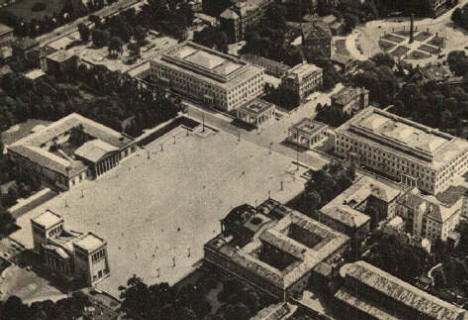
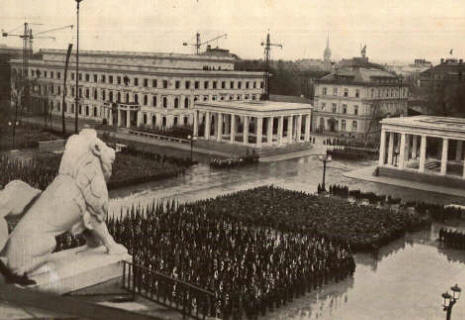
The temples were quickly and completely removed after the war, so I
found all these photos at
www.thirdreichinruins.com. Its a wonderful site to explore.
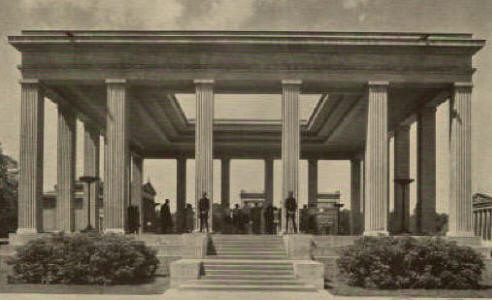
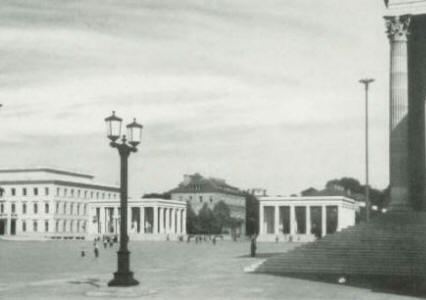
Each temple held 8 bodies each in their individual sarcophagus.
Each sarcophagus was labeled with the words "Der Letzte Appell" (The
Last Roll Call), the last name of the deceased, and "Hier" (Here).

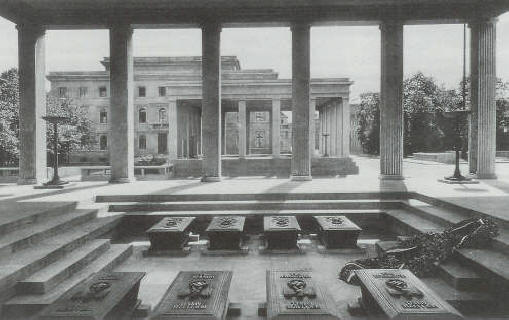
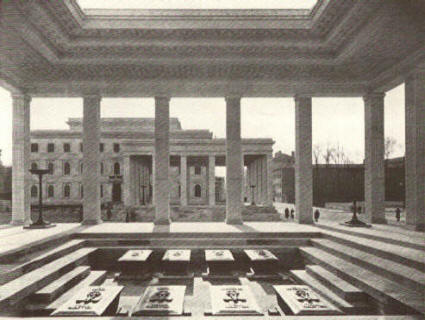
Note the intertwined swashtikas in the ceiling pattern (below left.)
SS soldiers kept guard for the memory of November 9, 1923.
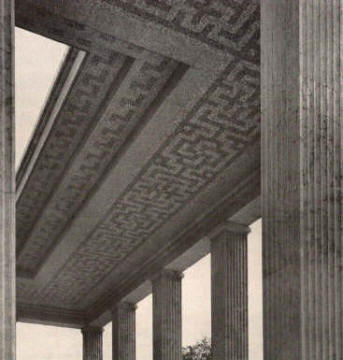

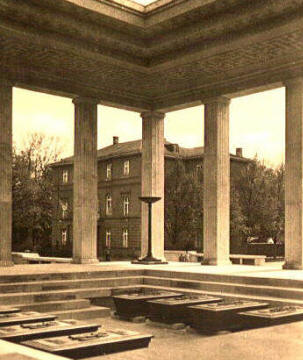
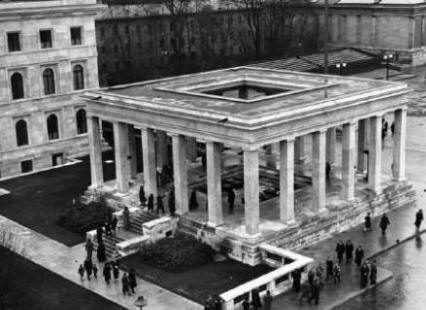
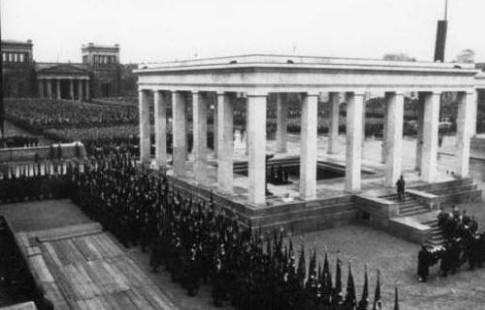
In January 1947 the U.S. Army occupation authorities ordered the
Ehrentempels to be destroyed. Below is a US Army soldier
inspecting the temple.
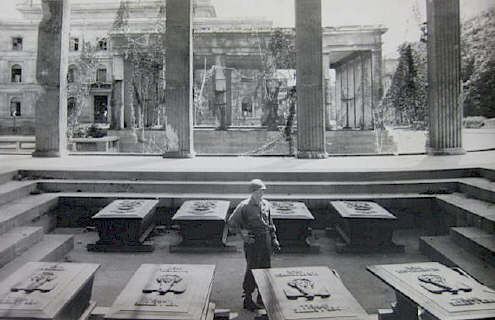
The sarcophagi had already been removed in 1945, and the bodies returned
to their families or buried in unmarked graves in various Munich
cemeteries. The cast-iron sarcophagi and inner tin coffins were
melted down and used in city reconstruction. The columns were
blown down and the roofs collapsed but their platforms remain today.
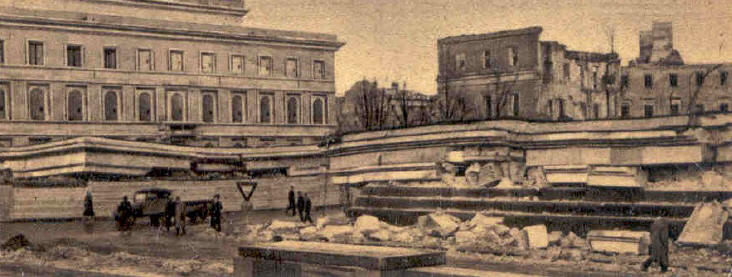
Two buildings of the Nazi party, constructed by
Paul Troost, next to the temples still exist. They are the
F�hrerbau (F�hrer Building) and the Verwaltungsbau (Administration
Building.)
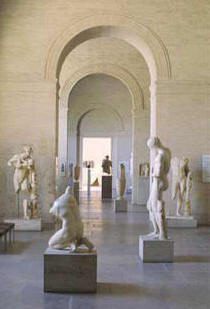
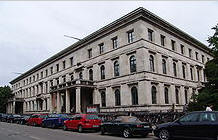 In
one of them, the F�hrerbau (left,) the
Munich Pact was signed in 1938. More on this below.
Today it has been turned into a school for music and theatre called the
Hochschule f�r Musik und Theater M�nchen. Now lets turn to the
two major museums located here.
In
one of them, the F�hrerbau (left,) the
Munich Pact was signed in 1938. More on this below.
Today it has been turned into a school for music and theatre called the
Hochschule f�r Musik und Theater M�nchen. Now lets turn to the
two major museums located here.
First I will show the
Glyptothek
[+49-8-928-6100]
 [�3.5,
senior �2.5, Sun �1] which I never got into because it was too late. Its a
shame because it contains sculptures dating from 650 BC to 550 AD. The
defined periods are:
Archaic period (700-490 BC,) the
Classical period (489�323 BC,) the
Hellenistic period (322�146 BC) and the
Roman period (150 BC-550 AD.) Above right is the the exhibits
displayed and below is my shot of the building.
[�3.5,
senior �2.5, Sun �1] which I never got into because it was too late. Its a
shame because it contains sculptures dating from 650 BC to 550 AD. The
defined periods are:
Archaic period (700-490 BC,) the
Classical period (489�323 BC,) the
Hellenistic period (322�146 BC) and the
Roman period (150 BC-550 AD.) Above right is the the exhibits
displayed and below is my shot of the building.
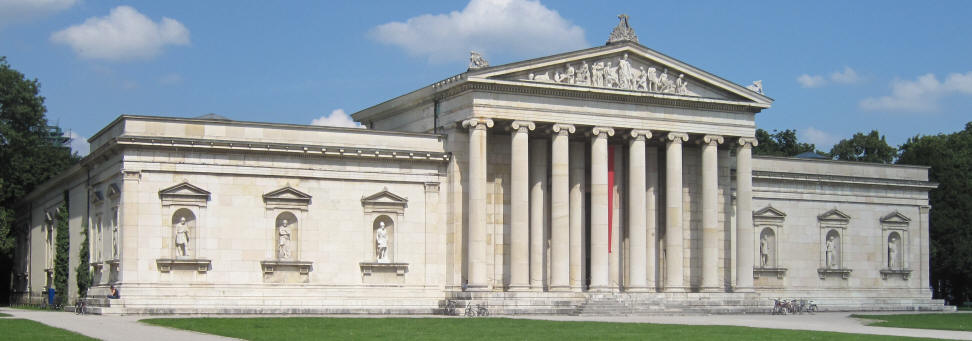
Below is a nice stock photo I found of the building.
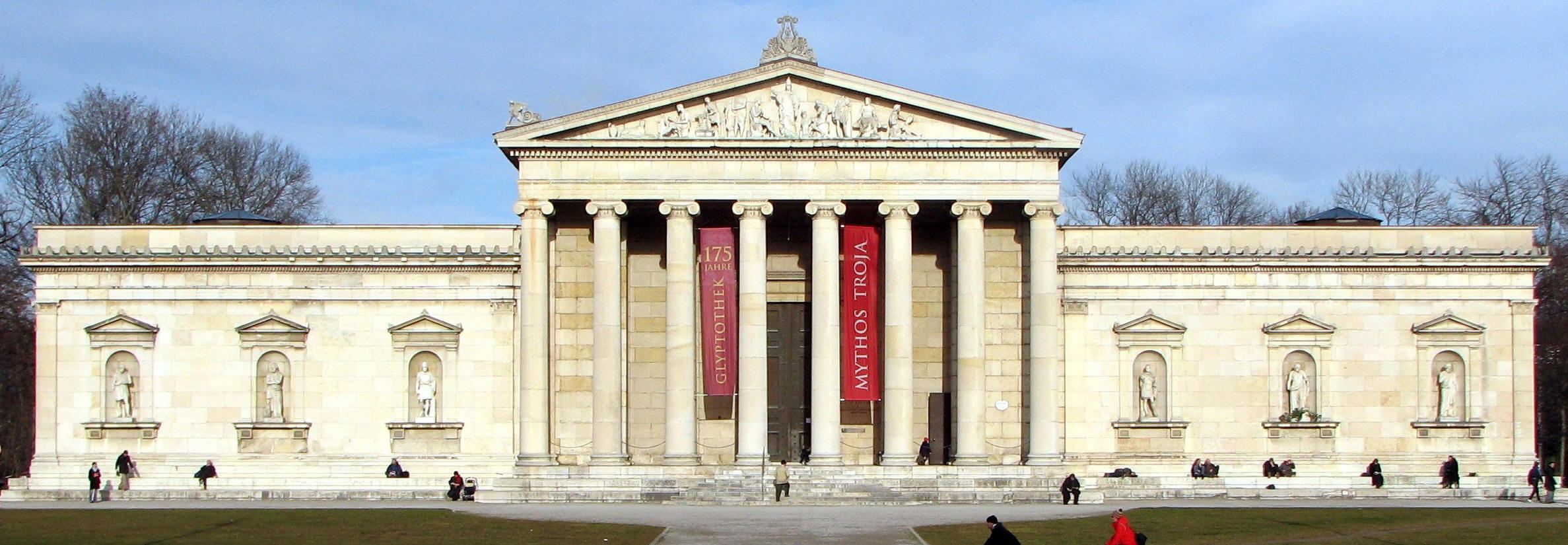
Below are some of their sculptures; below left is Septimus Severus (193-212AD,)
center left is "Faun" by Barberini, center right is a bronze Zeus (510BC) and
below right is a young man of Corinth (560-550 BC.)
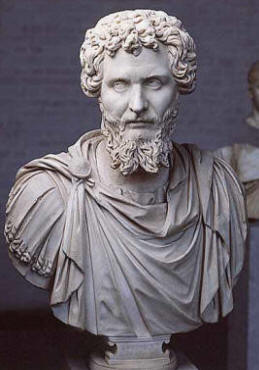
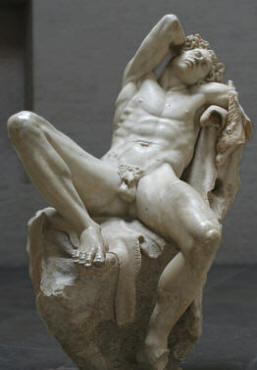


Below left is the Aphaia pediment
(505�500BC.)
In it are the 5 central figures of the west pediment of the
Temple of Aphaia.
From L-R are: Trojan soldier's feet, Ajax with a shield, the goddess Athena, a
Trojan warrior with shield and feet of Greek soldiers. According to myth,
Zeus raped the nymph Aigina, who bore the first king of the island,
Aiakos. Aiakos had the sons
Telamon
(father of the Homeric hero
Ajax) and
Peleus (father of the Homeric hero
Achilles.)
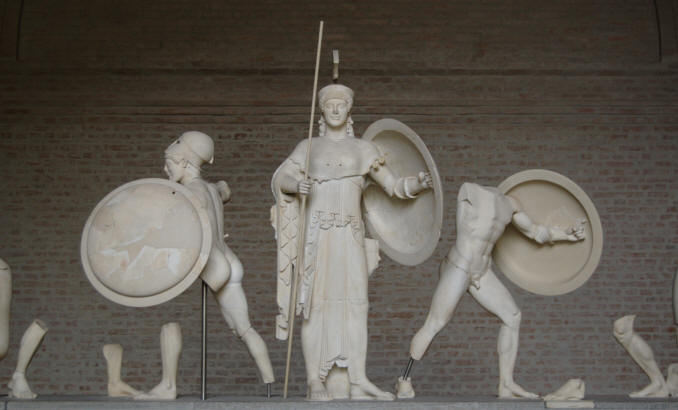
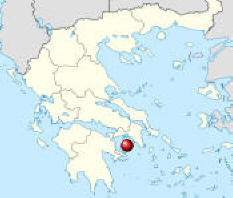
The temple is in Greece on the Island of
Aegina (Egina)
in the Saronic Gulf (above right and below.) You can see it is the largest
island in the center of the Gulf.
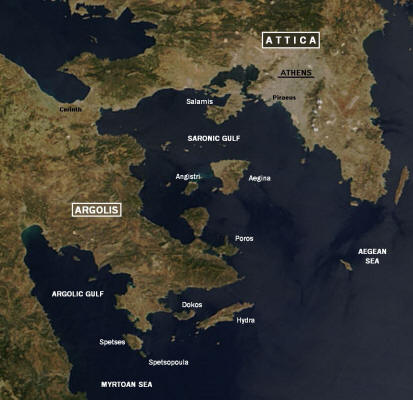
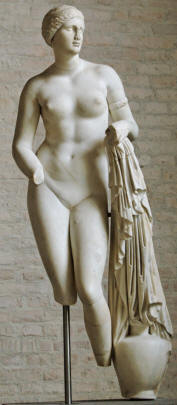
The museum also has the Roman
Venus Braschi from the Villa of the Quintilii outside Rome bought by Ludwig
I in 1811. It is a copy of the Greek Aphrodite statue by
Praxiteles. They
also have �Dying warrior� (fallen Trojan king, probably
Laomedon,) of the east
pediment of the temple (below left) and from the west pediment a fallen Trojan
warrior (below right.)
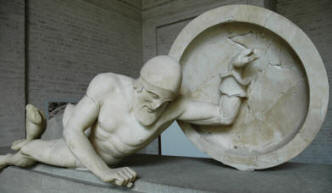
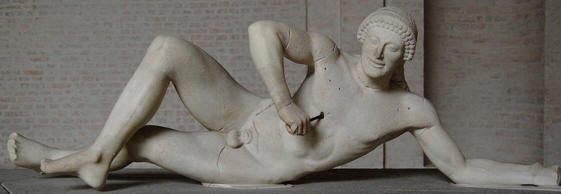
Below left are the ruins of the temple. Below right is the museum's stone
relief of Mnesarete (380 BC.)
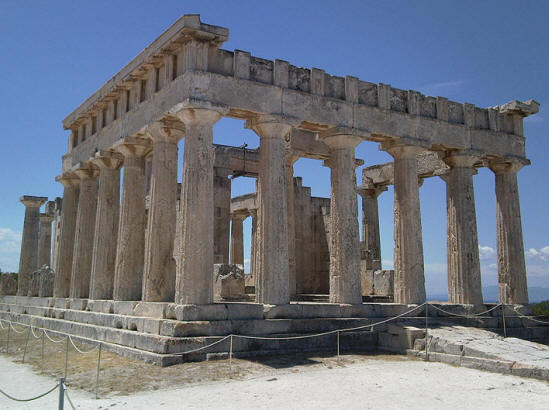

Mnesarete was known as Phryne because of her yellowish complexion and was a
famous Greek courtesan of the 4th C BC.
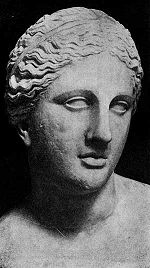
 She
was famously beautiful and was often the model for sculptures of Venus (left)
and Aphrodite (right) by
Praxiteles. She acquired so much wealth by her extraordinary beauty
that she offered to rebuild the walls of
Thebes, which had been destroyed by Alexander the Great (336 BC,) on
condition that the words "destroyed by Alexander, restored by Phryne the
courtesan," would be inscribed upon them but they turned down her offer.
In her famous trial before the court of Areopagus she supposedly stood nude and
was then acquitted. Here is the 1861 painting "Phryne
before the Areopagus" by
Jean-L�on G�r�me (below.)
She
was famously beautiful and was often the model for sculptures of Venus (left)
and Aphrodite (right) by
Praxiteles. She acquired so much wealth by her extraordinary beauty
that she offered to rebuild the walls of
Thebes, which had been destroyed by Alexander the Great (336 BC,) on
condition that the words "destroyed by Alexander, restored by Phryne the
courtesan," would be inscribed upon them but they turned down her offer.
In her famous trial before the court of Areopagus she supposedly stood nude and
was then acquitted. Here is the 1861 painting "Phryne
before the Areopagus" by
Jean-L�on G�r�me (below.)
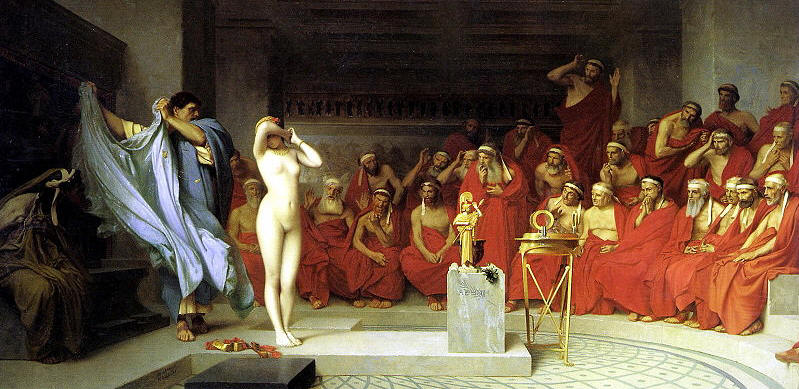
Now to the other museum on the other side of K�nigsplatz, the
Staatliche Antikensammlungen (below.)
.JPG)
.JPG)
This is the one I went in first. At 4:00 I climbed the stairs, past the
huge statue and discovered it was still open and bought a ticket (below) to visit
for �2.5.
.jpg)
.jpg)
The
Staatliche Antikensammlungen (State Collections of Antiquities)
[K�nigsplatz, +49-892-892-7503]
 is
a museum for the Bavarian state's antique collections of Greek, Etruscan and
Roman art. It was established by the Bavarian King
Ludwig I in 1848. The architect was
Georg Friedrich Ziebland. They let me know in no uncertain terms, that photography is strictly ferbotten.
is
a museum for the Bavarian state's antique collections of Greek, Etruscan and
Roman art. It was established by the Bavarian King
Ludwig I in 1848. The architect was
Georg Friedrich Ziebland. They let me know in no uncertain terms, that photography is strictly ferbotten.
As you can see
from my shots (below) it is filled with ancient sculptures and pottery from the Roman, Greek
and Persian civilizations.
.JPG)
.JPG)
.JPG)
Below is "Goldkranz aus Armento" (gold wreath on silver) (370-360 BC) which is a
golden decorated funerary or marriage crown found in a grave in Armento
(Campania,) Italy.
.JPG)
.jpg)
Below is a golden diadem from Pantekapelon, Ukraine
(300 BC.)
.JPG)
.jpg)
Below is my shot of some ancient jewelry. On the right is a better photo I
found of the gold flamboyant brooch with engraved jewelry plate, (early 7th C
BC) which is in my photo upper right.
.JPG)
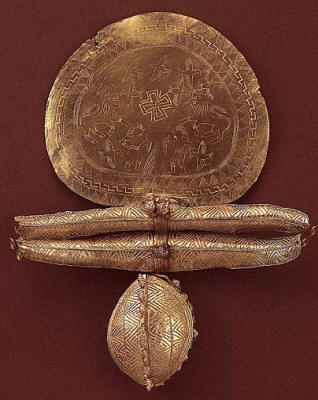
Here is a box of carved pieces and a painting of a Roman youth.
.jpg)
.jpg)
They had a lot of ancient pottery on display.
.JPG)
.JPG)
Below left is a famous 4th C. AD Roman goblet made of
reticella (or network) glass
which shows its Latin inscription "Bibe Multis Annis" ("drink many
years.") It was a present of the City of Cologne in return for King
Ludwig's support for the completion of the Cologne Cathedral. Below center
is the Dionysos Kylix (cup) by Greek artist
Exekias (550-25 BC) which is
pictured on my entry ticket. He worked mainly with a technique
called
black-figure. The painting on this cup depicts the initial journey of
the god Dionysos to Athens by ship. Pirates had seized the ship and were
going to sell him into slavery. Instead, the god caused vines to grow from
the mast, frig htening
the pirates and they jumped overboard and were changed into dolphins. Here
(right) is an example of Exekias' signature as a potter:
ΕΧΣΕΚΙΑΣ ΕΠΟΙΕΣΕ (�Exekias made me.�)
On the right is a photo I took of one of their Greek
urns.
htening
the pirates and they jumped overboard and were changed into dolphins. Here
(right) is an example of Exekias' signature as a potter:
ΕΧΣΕΚΙΑΣ ΕΠΟΙΕΣΕ (�Exekias made me.�)
On the right is a photo I took of one of their Greek
urns.
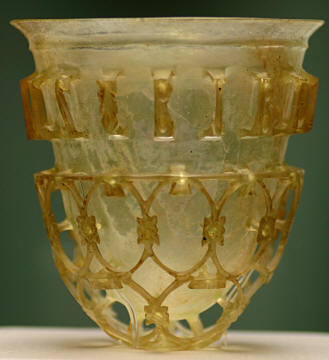
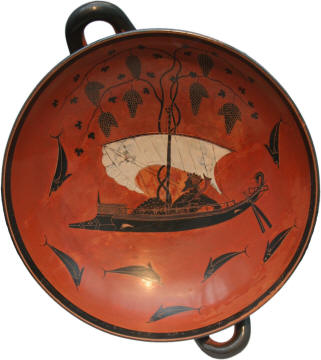
.JPG)
.JPG)
.JPG)
As you can see (above) they have a lot of different items. They were
closing just as I had finished seeing everything but there was no time to see
the Glyptothek. I left there and got this beautiful panorama of the entire
K�nigsplatz with the Staatsgalerie on the left, the gate in the center and the
Glyptothek on the right.
.JPG)
Below are some maps of the area.
.jpg)
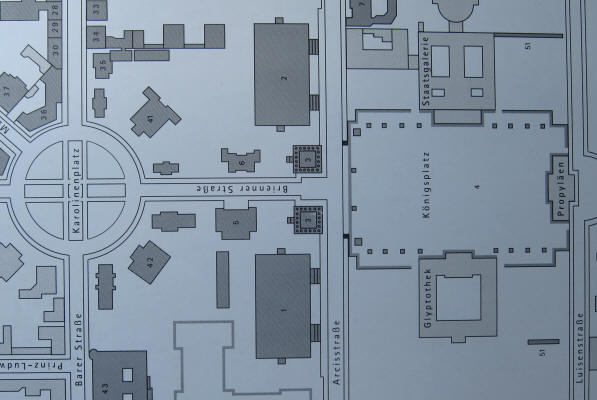
As I rounded the corner I photographed this building (below left,) not knowing
its historical importance. I later found out it was the F�hrerbau (F�hrer
Building) mentioned above. I don't know why I took a picture of it,
perhaps I thought it looked important. As I have now found out, it
certainly was. It was Hitler's headquasrters...
.JPG)

...and the
place where Prime Minister Neville Chamberlain (UK) and Prime Minister �douard
Deladier (France) (see flags below left) came and met with Hitler and Mussolini
(above right flags of Nazi Germany and Italy) and signed the Munich Pact on
September 30, 1938. This is considered the act of appeasement with Hitler
allowing him to swallow up the Sudetenland section of Czechoslovakia.
Below right you can see them all leaving this building after the signing.
Hitler got what he wanted; the others got "peace."
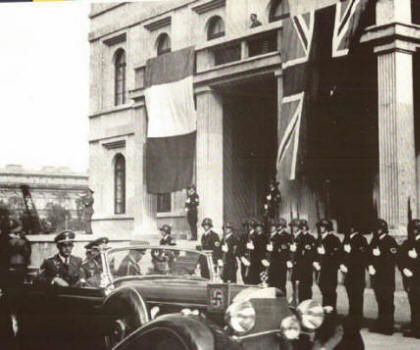
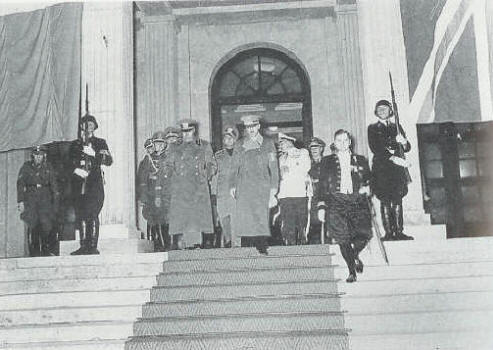
Below left is (L-R) Mussolini, Hitler, a translator and Chamberlain. Below
right is (L-R) Chamberlain, Deladier, Hitler, Mussolini, and Count Galeazzo
Ciano, Mussolini's foreign minister.
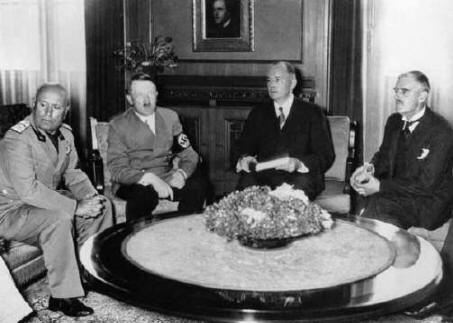
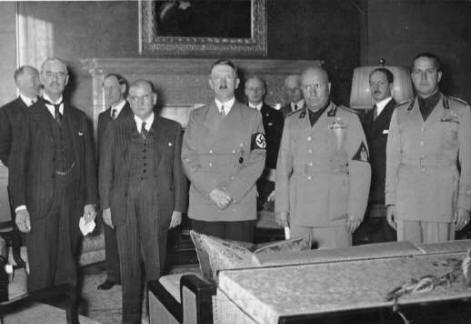
Below left is a photo of Hitler signing the Accord with foreign minister Joachim
von Ribbentrop looking on to the right. In the background, you can see
Hermann G�ring talking with Mussolini. Below right are the Nazis coming
out during a break.
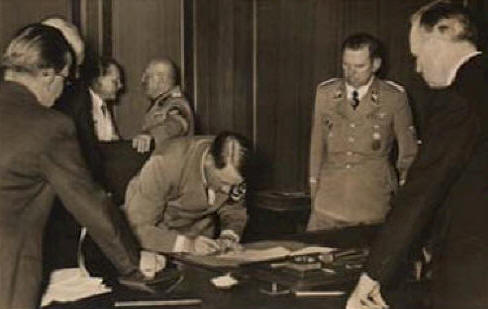
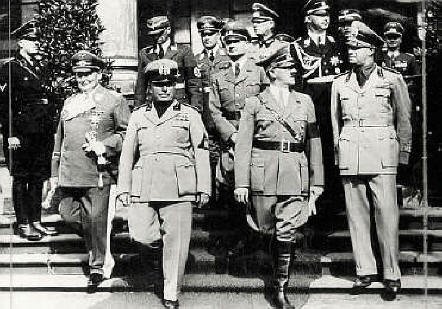
Below left is a photo from
www.thirdreichinruins.com looking toward Karolinenplatz where the
Ehrentempel used to be on the left and right with the office buildings on either
side. Below right is the shot I took as I headed away from K�nigsplatz.
See that column at the end of the street in both shots? It is the Obelisk
monument in the center of Karolinenplatz on Briennerstra�e (more tomorrow.)
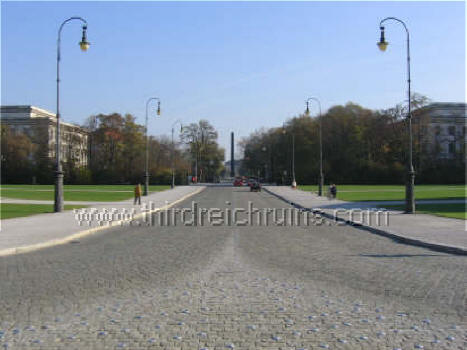
.JPG)
K�nigsplatz turns into Briennerstra�e on the other side of Karolinenplatz.
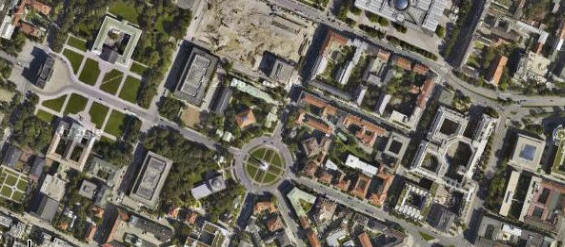
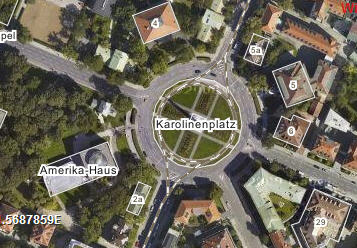
I walked around
 until I
hit a dead-end on Katharina-von-Bora-Stra�e (prev. Meiserstra�e) and found the
Park-Cafe [7
Sophienstra�e, +49-895-161-7980] which looked like a very inviting
place to get an afternoon refresher since I didn't see anything else around
anywhere.
until I
hit a dead-end on Katharina-von-Bora-Stra�e (prev. Meiserstra�e) and found the
Park-Cafe [7
Sophienstra�e, +49-895-161-7980] which looked like a very inviting
place to get an afternoon refresher since I didn't see anything else around
anywhere.
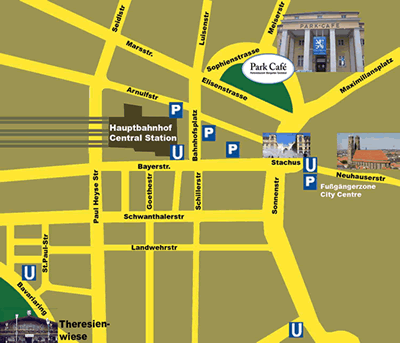
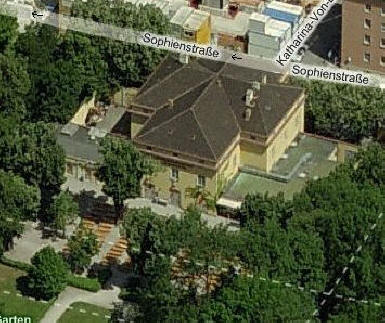
.JPG)
.JPG)
It was an impressive structure and I walked inside but there
was no one in there (above right) so I walked behind the bar into the back and discovered there was
this big Biergarten (below.) To get a beer, you have to go to that lineup of glass beer steins way
on the left, pick up what you want and then pay for it at the little green
shack.
.jpg)
.jpg) The
pretty young M�dchen (girl) in the shack takes my money and then hands me this little blue
chip. I asked her what it was and she told me it was a "Pfand." After
careful questioning I figured out they charged me extra for the glass, so if I
want my Euro back I bring the glass and the Pfand to her. At 4:30 I picked
my bench and sat amongst all the others who were enjoying an afternoon L�wenbr�u
(which is the only beer they sell - a very common practice for Biergartens here
in Germany.) I found this triple seed from one of the large trees nearby
and brought it home with me and planted it.
The
pretty young M�dchen (girl) in the shack takes my money and then hands me this little blue
chip. I asked her what it was and she told me it was a "Pfand." After
careful questioning I figured out they charged me extra for the glass, so if I
want my Euro back I bring the glass and the Pfand to her. At 4:30 I picked
my bench and sat amongst all the others who were enjoying an afternoon L�wenbr�u
(which is the only beer they sell - a very common practice for Biergartens here
in Germany.) I found this triple seed from one of the large trees nearby
and brought it home with me and planted it.
.JPG)
.jpg)
I pulled my computer out and
started work on my talks for the September Paris meeting (ESCRS.) I worked
so hard I had a second stein of beer.
.JPG)
I learned from their website that the building was built in 1935 and it has
always been a place for night time parties.

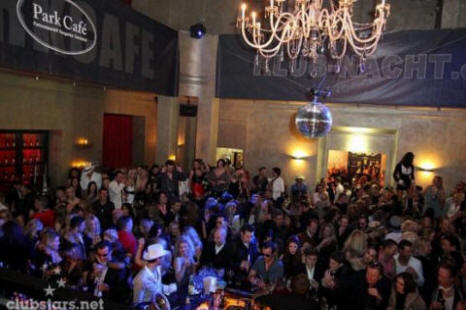
It appears they also serve food (below left.) Hugh Hefner used to party
here with a bevy of Playmates.
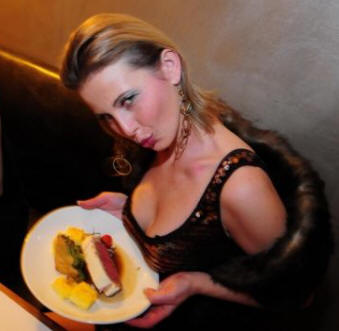
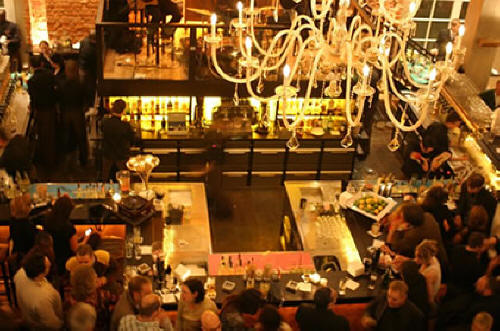
For those who enjoy them there are about 20 major beer gardens, with
four of the most famous and popular being located in the Englischer
Garten and the largest one in the Hirschgarten. Here are a few
with links to their websites:
Augustiner Br�u,
Paulaner,
Hacker-Pschorr,
Hofbr�u,
L�wenbr�u,
Spaten-Franziskaner-Br�u.
At 5:20 I turned my stein back in and got my refund for the deposit (Pfand) and then walked through the
Alter Botanische Garten (below,) which it is a part of, in an attempt to head back towards Karlsplatz.
.jpg)
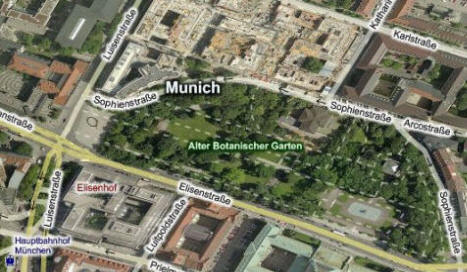
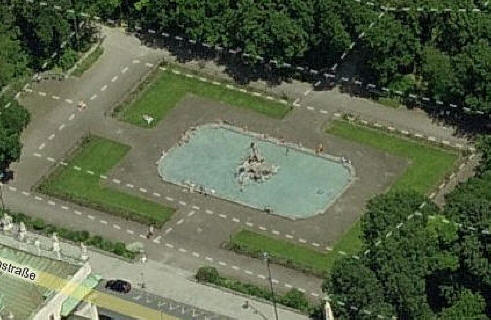
.JPG)
I went by the pond with the statuary in the center (above and below.)
.JPG)
.JPG)
I discovered that this sculpture of Neptune was done in 1937 by Third Reich
sculptor Josef Wackerle. Below is a shot of it after it was first erected.

There was this huge building in front of me which I
decided to go around on the left.
.JPG)
As you can see from the map below, I had to walk from the pond, down
Elisenstra�e, around the building via Karlsplatz and make a left on
Prielmayerstra�e to see the front of the complex.
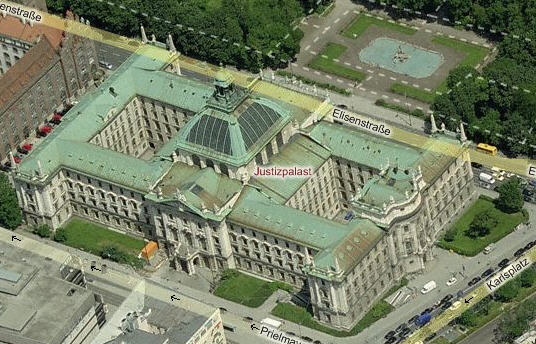
It is the Justizpalast (Palace of Justice) which was constructed in
1890-7 by the architect
Friedrich von Thiersch in neo-baroque style and houses the Bavarian
Department of Justice and the District Court I of Munich. In 1943
The
People's Court sentenced the members of the
White Rose (see above) in Room 253 which is now memorialized.
The center of the building is dominated by a 220 ft (67 m) glass dome
(below right.)
.jpg)
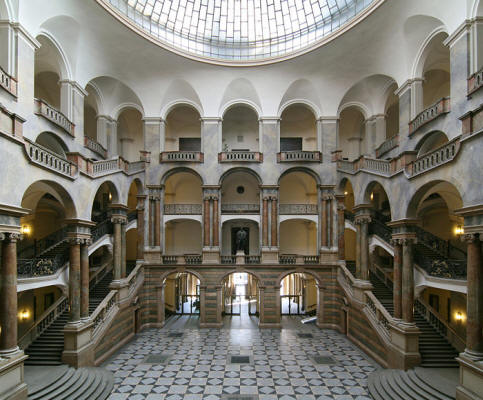
Above right is the main entry hall. As I can now see, the route I took
using the Ubahn was ridiculous (green arrows) because I could have easily walked
there on Briennerstra�e (red arrows.). My trek back is the brown arrows.
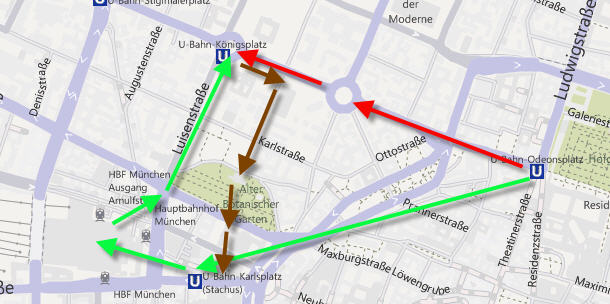
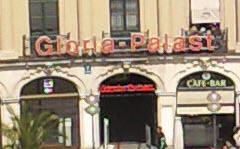
I finally arrived back at Karlsplatz and below is a stock aerial photo of it.
The large arched building on the left houses the
Glorie
Palast (above right) movie theater (click the link to find out what movies
are playing.)

Below are the panorama shots of it I took.
.jpg)
This was officially named Karlsplatz in 1797 after the unpopular
Charles Theodore, Elector of Bavaria. Munich natives seldom use that
name, calling it instead Stachus, after the pub Beim Stachus, once owned by
Eustachius F�derl, that was located there until construction work for
Karlsplatz began.
.JPG)
I continued on down Kaufingerstra�e and at 5:35 I decided to go inside and
revisit St. Michael Kirche. It was covered with a screen to hide the
scaffolding for refurbishment. The screen was a photo of how it used to
look (more tomorrow.)
.JPG)
%20(2).jpg)
.JPG)
I continued on down the street and just before entering Marienplatz I turned
right and decided to go into a neat place called
Zum Sp�ckmeier [9 Rosenstra�e,+49-8-926-8088.]
.JPG)
.jpg)
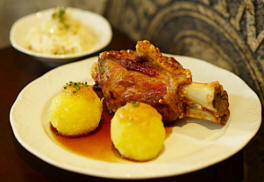 This is a Paulaner brewery p
This is a Paulaner brewery p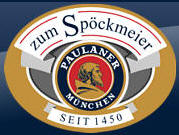 lace
(glasses on display above right) so at 6:40 I ordered a beer called Paulaner helles.
They also serve lots of food; right is a shot of their classic Bavarian
Schweinhaxn.
While sitting there I called Marcia to join me and she said she would be "just a few minutes."
That "few" turned out to be 60 minutes after which I bought her a glass of white
wine on her arrival.
lace
(glasses on display above right) so at 6:40 I ordered a beer called Paulaner helles.
They also serve lots of food; right is a shot of their classic Bavarian
Schweinhaxn.
While sitting there I called Marcia to join me and she said she would be "just a few minutes."
That "few" turned out to be 60 minutes after which I bought her a glass of white
wine on her arrival.
.JPG)
I had had two more waiting for her all that time. See the guy next to Marcia. He was totally inebriated
and before she got there, he kept chatting with me the entire time I was there
waiting. He was a riot.
.JPG)
.JPG)
We relaxed for a while and at 8:30, we walked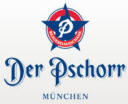 over to the
Viktualienmarkt area, but I needed an emergency pitstop before finding a
place to eat. We raced inside this nice white building called
Der Pschorr Wirtshaus
[Viktualienmarkt 15, + 49-895-181-8171.] It is run by Inka and J�rgen
Lochbihler. It was really packed when we arrived and I had to fight my way
to find the facilities. We decided to try their beer and wine.
over to the
Viktualienmarkt area, but I needed an emergency pitstop before finding a
place to eat. We raced inside this nice white building called
Der Pschorr Wirtshaus
[Viktualienmarkt 15, + 49-895-181-8171.] It is run by Inka and J�rgen
Lochbihler. It was really packed when we arrived and I had to fight my way
to find the facilities. We decided to try their beer and wine.

As can be
seen from their photos, it a big lively place and besides being a nice beer hall
they serve a wide variety of foods.
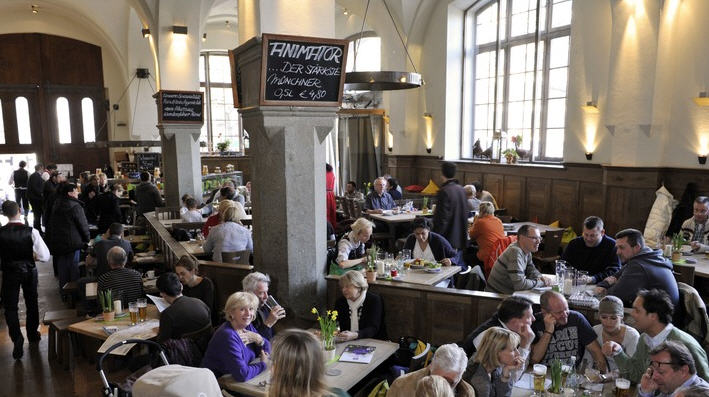
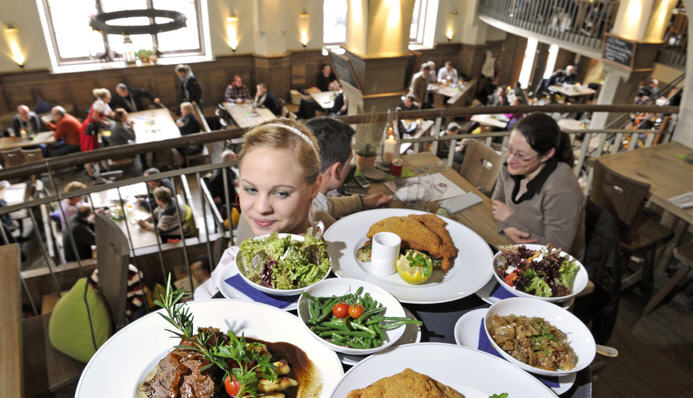
All the
waitresses wear their bright red Bavarian uniforms and you can even buy a pin
from Tamara here.
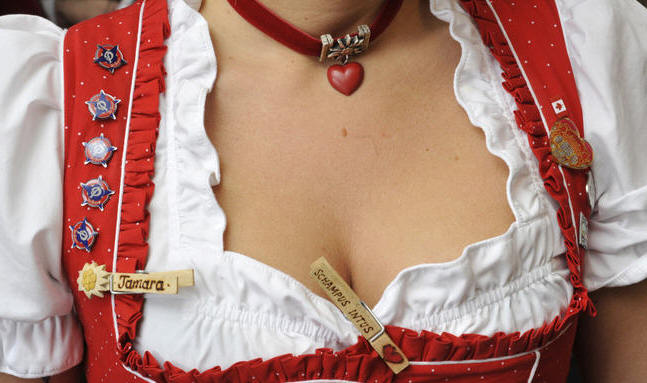
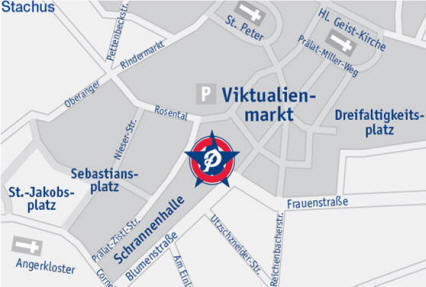
From the map
above, we left there and walked back up through the market stalls to St. Peters
Kirche looking
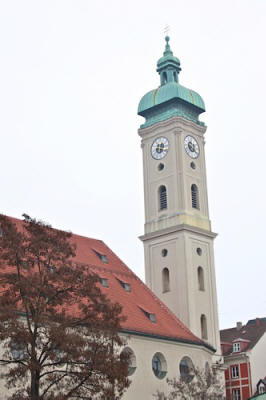 for
a place to have a nice dinner. We wandered south of St. Peters,
into Dreifaltigkeitsplatz where we came across the Gothic hall church
Heiliggeistkirche (The Church of the Holy Spirit) (left.) It was converted to
baroque in 1724 and looks down upon the
Viktualienmarkt. It
originally belonged to the Hospice of the Holy Ghost (14th C.,) was remodeled
in 1724-30 by Johann
for
a place to have a nice dinner. We wandered south of St. Peters,
into Dreifaltigkeitsplatz where we came across the Gothic hall church
Heiliggeistkirche (The Church of the Holy Spirit) (left.) It was converted to
baroque in 1724 and looks down upon the
Viktualienmarkt. It
originally belonged to the Hospice of the Holy Ghost (14th C.,) was remodeled
in 1724-30 by Johann
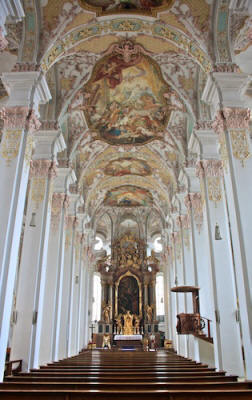 Georg
Ettenhofer and embellished with fine Rococo frescoes and stucco ornamentation by the
famous Asam brothers. The tower was built in 1730 and has a characteristic
Munich lantern dome (left.) After the demolition of the hospice buildings, in 1885, Franz L�wel added three
bays at the west end of the church and gave it an imposing neo-baroque fa�ade.
The church suffered severe damage during WWII and its interior furnishings
were largely destroyed. Extensive rebuilding and restoration was carried out
after the war. Of the original Gothic church there remain only the choir
buttresses and the north wall of the nave.
Georg
Ettenhofer and embellished with fine Rococo frescoes and stucco ornamentation by the
famous Asam brothers. The tower was built in 1730 and has a characteristic
Munich lantern dome (left.) After the demolition of the hospice buildings, in 1885, Franz L�wel added three
bays at the west end of the church and gave it an imposing neo-baroque fa�ade.
The church suffered severe damage during WWII and its interior furnishings
were largely destroyed. Extensive rebuilding and restoration was carried out
after the war. Of the original Gothic church there remain only the choir
buttresses and the north wall of the nave.
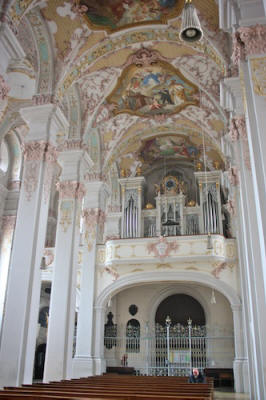
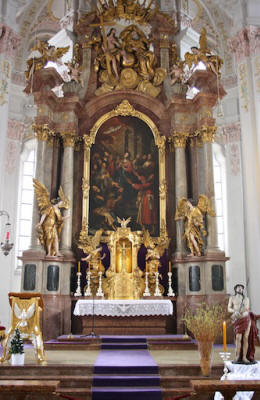

Looking to the rear of the church can be seen the organ (above left.) In
the chancel (above center) the high altar is by Nikolaus Stuber (1730,) with an
altarpiece by Ulrich Loth entitled "The Effusion of the Holy Spirit" (1661) and
two flanking angels by Johann Georg Greiff (1729.) On the right aisle
(above right,) a series of wall paintings (1725) by Peter Horeman illustrating
the "Seven Gifts of the Holy Spirit."
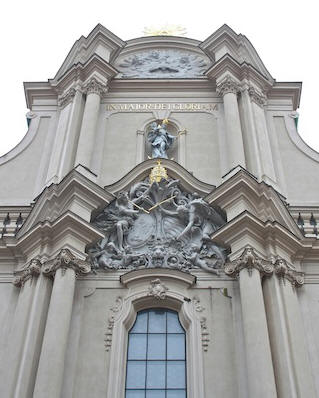
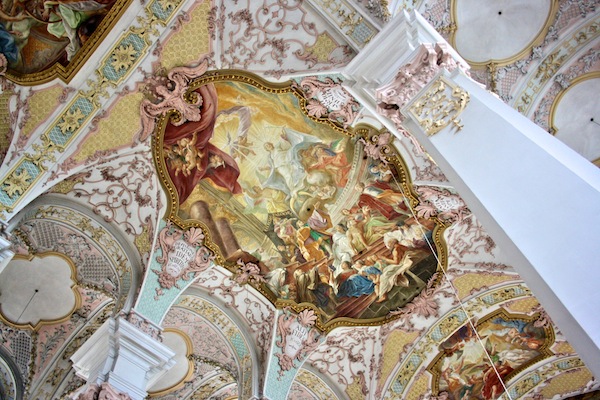
.JPG)
The
ceiling
(above right) and surrounding abutments are spectacular. The interior of the church was
again renovated at great expense in 1991. We decided at 8:50 we would have dinner at
Zum Alten Markt [3 Dreifaltigkeitsplatz,
 +49-8-929-9995.]
+49-8-929-9995.]
.JPG)
.JPG)
The name means "On the Old Market." They gave us a nice outdoor table
(above right) and we perused the menu.
.JPG)
.JPG)
.JPG)
.JPG)
I
had had enough beer so I ordered colkalite (3.4) and Marcia had two glasses of Gr�ner Veltliner
(10.4.) I then ordered the "Chef's Plate" (below left) which had a pork filet (upper
left), bavarian burger (lower left), sausages (center,) bacon, sauerkraut (center) and
potatoes (Wirtstelle mit Schweinfilet, W�rst'l und
Speck auf Sauerkraut und Nusskartoffeln.) There also is a split hot dog
standing in the center. (14.8)
.JPG)
.JPG)
.JPG)
Marcia had her favorite, filet of salmon trout (above right, below) with
rosemary-tomato butter on spinach and potatoes (Lachsforellenfilet mit Rosmarin
Tomattenbutter auf Blattspinat und Nusskartoffeln) (14.8)
.JPG)
.JPG)
Then for dessert, we split a apple pancak with vanilla ice cream (gratinierter
apfelpfannkuchen mit Rahmvanilleeis) (above right) (6.5.) Marcia took the
suggestion of our delightful waitress and had a glass of F�rst Fr�nkische
Wildkirsche Franconia Wildkirsch (7.8) (below.) We rated the overall
experience as good, not excellent.
.JPG)
.JPG)
At 10:30 we left and ambled our way back to our room and got to bed at 10:45.
I total crashed! Probably from all the walking. What a day.
KJH
Go
To -> NEXT DIARIO #7
Kenneth J. Hoffer, MD
KHofferMD@AOL.com

Munich, Germany
8/21/2010
Sent 2-18-2011
Return to
Top of Page
If you enjoyed these travels or wish to add comments on the places we visited
Please Leave Me a Message by clicking the spinning
@ sign below.
Click Here To: 




 Before that
Before that
 the
Guelph,
Henry the Lion (1129�95) (left) (Duke of Saxony and Bavaria) had
built a bridge over the Isar River next to a settlement of Benedictine
monks. This was on the Salt Route and was a toll bridge.
the
Guelph,
Henry the Lion (1129�95) (left) (Duke of Saxony and Bavaria) had
built a bridge over the Isar River next to a settlement of Benedictine
monks. This was on the Salt Route and was a toll bridge. Henry's
(left, marriage to Mathilde) ancestors were the House of Welf (in
English, Guelf or Guelph.) Family chart to the right. In
1070, Welf IV became Duke of Bavaria. His son
Welf V (1072-1120) (below left) married Countess
Matilda of Tuscany who died childless and
Henry's
(left, marriage to Mathilde) ancestors were the House of Welf (in
English, Guelf or Guelph.) Family chart to the right. In
1070, Welf IV became Duke of Bavaria. His son
Welf V (1072-1120) (below left) married Countess
Matilda of Tuscany who died childless and
 left
him all her possessions in Italy including
Tuscany,
Ferrara,
Modena,
Mantua,
and
Reggio. This played a big role in the
Investiture Controversy. Because the Welf dynasty
left
him all her possessions in Italy including
Tuscany,
Ferrara,
Modena,
Mantua,
and
Reggio. This played a big role in the
Investiture Controversy. Because the Welf dynasty
 sided
with the Pope in this controversy, partisans of the Pope came to be
known in Italy as "Guelphs." It is interesting to read the
Controversy and how it led to the first formation of the College of
Cardinals for election of the pope in 1059 and its final settlement in
the Concordant of Worms in 1122. Henry IX (1075-1126) (right),
called the Black, ruled from 1120 to 1126.
sided
with the Pope in this controversy, partisans of the Pope came to be
known in Italy as "Guelphs." It is interesting to read the
Controversy and how it led to the first formation of the College of
Cardinals for election of the pope in 1059 and its final settlement in
the Concordant of Worms in 1122. Henry IX (1075-1126) (right),
called the Black, ruled from 1120 to 1126.descendent and Duke of Hannover) inherited the British throne as King George I (left, guinea right) as a result of the Act of Settlement. His grandson George III (right) caused
the union of Britain and Ireland into the United Kingdom, lost the colonies in the American Revolution, finally defeated Napoleon and died mentally ill from porphyria. The Welf dynasty continued to rule Great Britain (where they were known as the House of
Hanover) until the death of his granddaughter Queen Victoria in 1901. In 1913, a descendent, Ernst August, married the daughter of Kaiser Wilhelm II and was allowed to inherit the duchy of Hanover. His rule there was short-lived, however, as the monarchy came to an end following WWI in 1918. The Welf dynasty continues to exist today and its current head, Ernst August V, is the third and present husband (left) of Princess Caroline of Monaco (they are now separated.)
 shown in the map. He was succeeded by
Otto I Wittelsbach (right) (1117-83) called the Redhead (der Rotkopf)
who
shown in the map. He was succeeded by
Otto I Wittelsbach (right) (1117-83) called the Redhead (der Rotkopf)
who ruled from 1180-3. Otto was the first Bavarian ruler from the
House of Wittelsbach and became so after the trial of Henry the Lion who
was then deposed by his cousin, Emperor Barbarossa. His
descendants (the
Wittelsbach dynasty
ruled from 1180-3. Otto was the first Bavarian ruler from the
House of Wittelsbach and became so after the trial of Henry the Lion who
was then deposed by his cousin, Emperor Barbarossa. His
descendants (the
Wittelsbach dynasty )
ruled Bavaria for the next 738 years until 1918. It is very
interesting to click the above link and see the whole lineage. In
1240, Munich was transferred to his son
Otto II Wittelsbach (1206�53) (right) and in 1255, when the Duchy of
Bavaria was split in two, Munich became the ducal residence of
Upper Bavaria (the southern part.)
)
ruled Bavaria for the next 738 years until 1918. It is very
interesting to click the above link and see the whole lineage. In
1240, Munich was transferred to his son
Otto II Wittelsbach (1206�53) (right) and in 1255, when the Duchy of
Bavaria was split in two, Munich became the ducal residence of
Upper Bavaria (the southern part.) ,
was elected German king in 1314, King of Italy in 1327 and crowned as
Holy Roman Emperor in 1328. This Wittelsbach was a real big
shot. He strengthened Munich's position by granting it the salt
monopoly, thus assuring it of additional income. In January 1328,
Louis marched into Italy, entered Rome and had himself crowned emperor
by the aged senator
Sciarra Colonna. Three months later
,
was elected German king in 1314, King of Italy in 1327 and crowned as
Holy Roman Emperor in 1328. This Wittelsbach was a real big
shot. He strengthened Munich's position by granting it the salt
monopoly, thus assuring it of additional income. In January 1328,
Louis marched into Italy, entered Rome and had himself crowned emperor
by the aged senator
Sciarra Colonna. Three months later
 Louis
published a decree declaring "Jacque de Cahors" (Pope
John XXII) (left) deposed on grounds of heresy. There was some
basis for this, by the way. The popes were in Avignon at that time
living quite well under French protection (See France Diarios.)
Louis
published a decree declaring "Jacque de Cahors" (Pope
John XXII) (left) deposed on grounds of heresy. There was some
basis for this, by the way. The popes were in Avignon at that time
living quite well under French protection (See France Diarios.) .
Pietro was the 32nd of 39 Antipopes in the history of the Church.
In fulfillment of an oath he made, on his return from Italy, Louis
founded
Ettal Abbey on April 28, 1330. We will be there next
week.
.
Pietro was the 32nd of 39 Antipopes in the history of the Church.
In fulfillment of an oath he made, on his return from Italy, Louis
founded
Ettal Abbey on April 28, 1330. We will be there next
week. Vacation
Rentals
Vacation
Rentals




 Duke
Duke

 when
when
 Sweden
(below left) invaded Bavaria during the Thirty Years� War and occupied
the city. He threatened to sack and burn the entire city of
Munich but would leave the city in peace if the citizens surrendered
some hostages and 600,000 barrels of Hofbr�uhaus beer. This
literally saved the city.
Sweden
(below left) invaded Bavaria during the Thirty Years� War and occupied
the city. He threatened to sack and burn the entire city of
Munich but would leave the city in peace if the citizens surrendered
some hostages and 600,000 barrels of Hofbr�uhaus beer. This
literally saved the city. Gustav was killed in a later battle and his daughter
Gustav was killed in a later battle and his daughter
 one
third of the population died. Under the regency of the Bavarian
Electors, Munich was an important center of baroque life but also had to
suffer under
one
third of the population died. Under the regency of the Bavarian
Electors, Munich was an important center of baroque life but also had to
suffer under
 in
1706 but regained it in 1714 by the
in
1706 but regained it in 1714 by the
 (1745-77)
was childless and became the last of the direct Wittelsbach line from
Louis IV. He was succeeded by
(1745-77)
was childless and became the last of the direct Wittelsbach line from
Louis IV. He was succeeded by
.jpg/80px-Kurf�rst_Karl_Theodor_(Bayern).jpg)

 the
erection of many of the city's finest buildings. With Napoleon
causing the collapse of the Holy Roman Empire, the Prince (Emperor)
Elector of Bavaria,
the
erection of many of the city's finest buildings. With Napoleon
causing the collapse of the Holy Roman Empire, the Prince (Emperor)
Elector of Bavaria,





 (below
left) who rules from 1864 until his untimely suspicious
(below
left) who rules from 1864 until his untimely suspicious
 death
by drowning in Lake Starnberger See (left) near the small town of Berg
in 1886. He built the famous castles (including the "fairytale"
Schloss Neuschwanstein castle (right)) and practically bankrupted the
kingdom in the process. He built one on the small and only island
on the lake called Roseninsel. He was succeeded by his brother
Otto (below right) from 1886-1913. But after ruling for 27 years,
poor Otto developed mental illness and he had to be confined. He
was replaced by his older relative, Ludwig III from 1913-18 (see below.)
death
by drowning in Lake Starnberger See (left) near the small town of Berg
in 1886. He built the famous castles (including the "fairytale"
Schloss Neuschwanstein castle (right)) and practically bankrupted the
kingdom in the process. He built one on the small and only island
on the lake called Roseninsel. He was succeeded by his brother
Otto (below right) from 1886-1913. But after ruling for 27 years,
poor Otto developed mental illness and he had to be confined. He
was replaced by his older relative, Ludwig III from 1913-18 (see below.)



 French
air raids in 1916, three bombs fell on Munich. After the war, the
city was the center of much political unrest. In November 1918, on
the eve of a revolution,
French
air raids in 1916, three bombs fell on Munich. After the war, the
city was the center of much political unrest. In November 1918, on
the eve of a revolution,

 wearing
both black and red arm bands. Anton received the death
penalty which a conservative judge reduced to 5 years. He was
released from prison to make room for Hitler to take his cell (ironic,
see below.)
wearing
both black and red arm bands. Anton received the death
penalty which a conservative judge reduced to 5 years. He was
released from prison to make room for Hitler to take his cell (ironic,
see below.)







 It was moved to this location in 1607 by his son Maximillian I.
The beer quickly became world famous thanks to the first brewer,
Heimeran Pongratz, and the famous �Bavarian Beer Purity Law� of
1516 that stated that only natural ingredients could be used in
the brewing process. King Ludwig I in 1828, issued a
decree that opened up the
It was moved to this location in 1607 by his son Maximillian I.
The beer quickly became world famous thanks to the first brewer,
Heimeran Pongratz, and the famous �Bavarian Beer Purity Law� of
1516 that stated that only natural ingredients could be used in
the brewing process. King Ludwig I in 1828, issued a
decree that opened up the
 Hofbr�uhaus
to the public, marking the
Hofbr�uhaus
to the public, marking the onset of the operation of the Hofbr�uhaus at Platzl as we know
it today. In 1852 Maximillian II transferred it to the
Bavarian State. In 1879, they patented this logo (left) to
prevent others from using it.
onset of the operation of the Hofbr�uhaus at Platzl as we know
it today. In 1852 Maximillian II transferred it to the
Bavarian State. In 1879, they patented this logo (left) to
prevent others from using it.
 Prince
Regent Luitpold decided to move the brewery out of the
Hofbr�uhaus and to build a completely new brewing site (left)
above the storage cellars on Innere Wiener Street. The
last batch of beer was brewed at the old site on May 22, 1896.
The new Hofbr�uhaus
Prince
Regent Luitpold decided to move the brewery out of the
Hofbr�uhaus and to build a completely new brewing site (left)
above the storage cellars on Innere Wiener Street. The
last batch of beer was brewed at the old site on May 22, 1896.
The new Hofbr�uhaus
 opened
on September 22, 1897. On the night of April 25, 1944, the
first airborne bombs struck the Hofbr�uhaus. Three subsequ
opened
on September 22, 1897. On the night of April 25, 1944, the
first airborne bombs struck the Hofbr�uhaus. Three subsequ ent
air raids almost completely destroyed the building and only a
small section of the main beer hall was still operational � all
other rooms had been destroyed. Just in time for Munich �s
800th anniversary, the Hofbr�uhaus� new Festival Hall reopened,
marking the end of the renovation work. Today it is run by
the landlords, Wolfgang and Michael Sperger. To buy HB
products click
ent
air raids almost completely destroyed the building and only a
small section of the main beer hall was still operational � all
other rooms had been destroyed. Just in time for Munich �s
800th anniversary, the Hofbr�uhaus� new Festival Hall reopened,
marking the end of the renovation work. Today it is run by
the landlords, Wolfgang and Michael Sperger. To buy HB
products click
 the
block from the famous beer hall
the
block from the famous beer hall
 in
the late 18th Century. In a poem he wrote, Mozart claimed
to have written the opera "Idomeneo" after several visits to the
Hofbr�uhaus fortified him for the task. In the 19th
Century, most of the breweries in Munich, including the
Hofbr�uhaus, were converted into large beer halls, restaurants,
and entertainment centers with large, cavernous meeting rooms
for weddings, concerts, and plays. In the period after
WWI, the beer halls of Munich became swept up in the chaotic
politics of the period. Vladimir Lenin lived in Munich
just before WWI and reportedly visited the Hofbr�uhaus on a
regular basis. In 1919, the Munich Communist government
set up
in
the late 18th Century. In a poem he wrote, Mozart claimed
to have written the opera "Idomeneo" after several visits to the
Hofbr�uhaus fortified him for the task. In the 19th
Century, most of the breweries in Munich, including the
Hofbr�uhaus, were converted into large beer halls, restaurants,
and entertainment centers with large, cavernous meeting rooms
for weddings, concerts, and plays. In the period after
WWI, the beer halls of Munich became swept up in the chaotic
politics of the period. Vladimir Lenin lived in Munich
just before WWI and reportedly visited the Hofbr�uhaus on a
regular basis. In 1919, the Munich Communist government
set up
 headquarters
in the famous beer hall, and in 1920 Adolf Hitler and the
National Socialists held their first meeting in the Festsaal
(Festival Room) on the third floor. It was used by the
headquarters
in the famous beer hall, and in 1920 Adolf Hitler and the
National Socialists held their first meeting in the Festsaal
(Festival Room) on the third floor. It was used by the



 attraction.
Hofbr�uhauses have opened in Hamburg (2005,) Bremen (2008,)
Regensburg, Kaiserslautern and Berchtesgaden.
Hofbr�uhauses have been operating in Melbourne, Australia since
1968 as
attraction.
Hofbr�uhauses have opened in Hamburg (2005,) Bremen (2008,)
Regensburg, Kaiserslautern and Berchtesgaden.
Hofbr�uhauses have been operating in Melbourne, Australia since
1968 as
 well
as Newport, Kentucky (2003,) Las Vegas, Miami Beach, Chicago,
Milwaukee, and Pittsburgh (2009.) They are also in
well
as Newport, Kentucky (2003,) Las Vegas, Miami Beach, Chicago,
Milwaukee, and Pittsburgh (2009.) They are also in
.jpg) cino at SFCC
(above left)
cino at SFCC
(above left)
.jpg) doing my usual daily computer
chores. At 11:00 I walked across the street (above right,) through the
gate and did my run in the Hofgarten (below) and calculated, using my pedometer,
that it takes 4 circuits around the the outer lane of the park to make a mile
(1.61 km.)
doing my usual daily computer
chores. At 11:00 I walked across the street (above right,) through the
gate and did my run in the Hofgarten (below) and calculated, using my pedometer,
that it takes 4 circuits around the the outer lane of the park to make a mile
(1.61 km.)

.jpg)

 outdoor seating on both sides of the wall. I took this photo (below) of
the sign showing the extent of the famous Englischer Garten, which is the
largest park within the city limits of any city. I did not go there
because we have covered it on several previous trips. It is definitely
worthwhile visiting, especially the 4 major biergartens they have there.
outdoor seating on both sides of the wall. I took this photo (below) of
the sign showing the extent of the famous Englischer Garten, which is the
largest park within the city limits of any city. I did not go there
because we have covered it on several previous trips. It is definitely
worthwhile visiting, especially the 4 major biergartens they have there..jpg)

.jpg)
.jpg)
.jpg)

.jpg)
.jpg)
.jpg) Briennerstra�e and I got a shot of
this excellent watercolor by
Briennerstra�e and I got a shot of
this excellent watercolor by
.jpg)
.jpg)
 At 12:10 Marcia was out buying arch pads at Orthofit [6 F�rbergraben,
+49-892-350-8270] nearby the hotel and then went to the same Rosen Apoteke
before having lunch at Vinzenzmurr [8 Marienplatz, +49-8-922-1938.] They
are famous for their sausages.
At 12:10 Marcia was out buying arch pads at Orthofit [6 F�rbergraben,
+49-892-350-8270] nearby the hotel and then went to the same Rosen Apoteke
before having lunch at Vinzenzmurr [8 Marienplatz, +49-8-922-1938.] They
are famous for their sausages..jpg)

.jpg)
.jpg)
.jpg) level,
is home to a large shopping mall which is soon due for renovation. Large
shops like Kaufhof have branches here. Level 2 has a branch of the
Stadtsparkasse, a large local bank, as well as ticket counters and eateries.
Level 3 holds the S-Bahn station with two tracks and three platforms, arranged
in the Spanish solution (the island platform is for boarding only and the side
platforms are for disembarking.) The lines S1-2 and S4-8 stop here.
Level 4 allows interchange between the S-Bahn and U-Bahn. Level 5 holds
the U-Bahn station with two tracks and two platforms. Lines U4 and U5 stop
here, travelling in a N-W direction. The station is the deepest in the
whole network and thus has the longest escalator.
level,
is home to a large shopping mall which is soon due for renovation. Large
shops like Kaufhof have branches here. Level 2 has a branch of the
Stadtsparkasse, a large local bank, as well as ticket counters and eateries.
Level 3 holds the S-Bahn station with two tracks and three platforms, arranged
in the Spanish solution (the island platform is for boarding only and the side
platforms are for disembarking.) The lines S1-2 and S4-8 stop here.
Level 4 allows interchange between the S-Bahn and U-Bahn. Level 5 holds
the U-Bahn station with two tracks and two platforms. Lines U4 and U5 stop
here, travelling in a N-W direction. The station is the deepest in the
whole network and thus has the longest escalator..jpg)
.jpg)

.jpg) stand. I went inside and
stand. I went inside and
 headed to the other end of the station and went outside
onto Arnulfstra�e (left.) I tried looking at maps
and asking directions. At 3:15, I just kept walking and I wound up at the corner of Luisenstra
headed to the other end of the station and went outside
onto Arnulfstra�e (left.) I tried looking at maps
and asking directions. At 3:15, I just kept walking and I wound up at the corner of Luisenstra
 discovered is the
discovered is the
 in
the palace near Lake Stargensee. Luise was in the famous painting of the
three sisters (below left) by
in
the palace near Lake Stargensee. Luise was in the famous painting of the
three sisters (below left) by




 So at
3:40 I found this huge red circle sculpture (below) and came to find out I was
at the side
of the Charles Hotel, a very upscale hotel. In my running shorts, I went inside this very posh place
and begged for directions. The nice lady told me I was very close and it
was just two more blocks.
So at
3:40 I found this huge red circle sculpture (below) and came to find out I was
at the side
of the Charles Hotel, a very upscale hotel. In my running shorts, I went inside this very posh place
and begged for directions. The nice lady told me I was very close and it
was just two more blocks.


%20(2).jpg)



 K�nigsplatz area is a huge parade
K�nigsplatz area is a huge parade
 ground.
The Propyl�en has Doric columns (left,) while the
ground.
The Propyl�en has Doric columns (left,) while the
 (below
left.) K�nigsplatz is completed by the
(below
left.) K�nigsplatz is completed by the






 Ehrentempel)
(below) were erected at the east end of the square (left, below right)
for the remains of the 16 Nazis who died in the 1923 Beer Hall Putsch.
In 1935, the bodies of the 16 dead putschists were removed from their
various graves and placed in cast-iron sarcophagi, which lay in state at
the Feldherrenhalle (see yesterday) on November 8. The next day
the sarcophagi were placed in the Ehrentempel during elaborate
ceremonies.
Ehrentempel)
(below) were erected at the east end of the square (left, below right)
for the remains of the 16 Nazis who died in the 1923 Beer Hall Putsch.
In 1935, the bodies of the 16 dead putschists were removed from their
various graves and placed in cast-iron sarcophagi, which lay in state at
the Feldherrenhalle (see yesterday) on November 8. The next day
the sarcophagi were placed in the Ehrentempel during elaborate
ceremonies.














 In
one of them, the F�hrerbau (left,) the
In
one of them, the F�hrerbau (left,) the














 She
was famously beautiful and was often the model for sculptures of Venus (left)
and Aphrodite (right) by
She
was famously beautiful and was often the model for sculptures of Venus (left)
and Aphrodite (right) by 
.jpg)
.jpg)
.jpg)
.jpg)

.jpg)
.jpg)
 htening
the pirates and they jumped overboard and were changed into dolphins. Here
(right) is an example of Exekias' signature as a potter:
htening
the pirates and they jumped overboard and were changed into dolphins. Here
(right) is an example of Exekias' signature as a potter:


.jpg)










 until I
hit a dead-end on Katharina-von-Bora-Stra�e (prev. Meiserstra�e) and found the
until I
hit a dead-end on Katharina-von-Bora-Stra�e (prev. Meiserstra�e) and found the


.jpg)
.jpg) The
pretty young M�dchen (girl) in the shack takes my money and then hands me this little blue
chip. I asked her what it was and she told me it was a "Pfand." After
careful questioning I figured out they charged me extra for the glass, so if I
want my Euro back I bring the glass and the Pfand to her. At 4:30 I picked
my bench and sat amongst all the others who were enjoying an afternoon L�wenbr�u
(which is the only beer they sell - a very common practice for Biergartens here
in Germany.) I found this triple seed from one of the large trees nearby
and brought it home with me and planted it.
The
pretty young M�dchen (girl) in the shack takes my money and then hands me this little blue
chip. I asked her what it was and she told me it was a "Pfand." After
careful questioning I figured out they charged me extra for the glass, so if I
want my Euro back I bring the glass and the Pfand to her. At 4:30 I picked
my bench and sat amongst all the others who were enjoying an afternoon L�wenbr�u
(which is the only beer they sell - a very common practice for Biergartens here
in Germany.) I found this triple seed from one of the large trees nearby
and brought it home with me and planted it..jpg)




.jpg)




.jpg)




.jpg)
%20(2).jpg)
.jpg)
 This is a Paulaner brewery p
This is a Paulaner brewery p lace
(glasses on display above right) so at 6:40 I ordered a beer called Paulaner helles.
They also serve lots of food; right is a shot of their classic Bavarian
Schweinhaxn.
While sitting there I called Marcia to join me and she said she would be "just a few minutes."
That "few" turned out to be 60 minutes after which I bought her a glass of white
wine on her arrival.
lace
(glasses on display above right) so at 6:40 I ordered a beer called Paulaner helles.
They also serve lots of food; right is a shot of their classic Bavarian
Schweinhaxn.
While sitting there I called Marcia to join me and she said she would be "just a few minutes."
That "few" turned out to be 60 minutes after which I bought her a glass of white
wine on her arrival. over to the
over to the





 for
a place to have a nice dinner. We wandered south of St. Peters,
into Dreifaltigkeitsplatz where we came across the Gothic hall church
for
a place to have a nice dinner. We wandered south of St. Peters,
into Dreifaltigkeitsplatz where we came across the Gothic hall church
 Georg
Ettenhofer and embellished with fine Rococo frescoes and stucco ornamentation by the
famous Asam brothers. The tower was built in 1730 and has a characteristic
Munich lantern dome (left.) After the demolition of the hospice buildings, in 1885, Franz L�wel added three
bays at the west end of the church and gave it an imposing neo-baroque fa�ade.
The church suffered severe damage during WWII and its interior furnishings
were largely destroyed. Extensive rebuilding and restoration was carried out
after the war. Of the original Gothic church there remain only the choir
buttresses and the north wall of the nave.
Georg
Ettenhofer and embellished with fine Rococo frescoes and stucco ornamentation by the
famous Asam brothers. The tower was built in 1730 and has a characteristic
Munich lantern dome (left.) After the demolition of the hospice buildings, in 1885, Franz L�wel added three
bays at the west end of the church and gave it an imposing neo-baroque fa�ade.
The church suffered severe damage during WWII and its interior furnishings
were largely destroyed. Extensive rebuilding and restoration was carried out
after the war. Of the original Gothic church there remain only the choir
buttresses and the north wall of the nave.






